Spring Program 2023



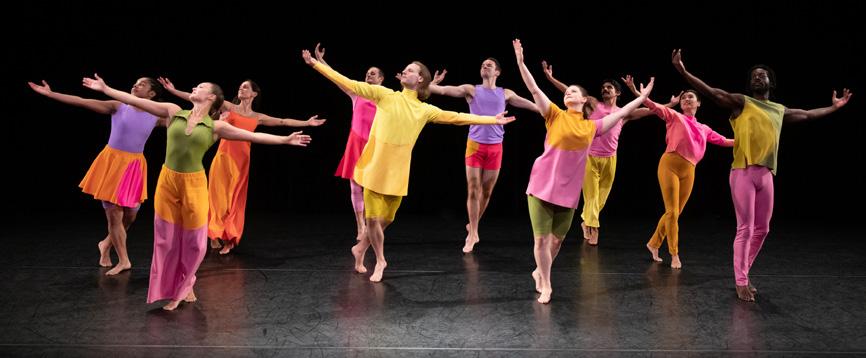

















Following a winter season that showered us with rapturous moments, the buds of a bold spring are not far behind.
Experience improvisation at its finest when A&L mainstay Wynton Marsalis (Apr 4) makes a unique return with a septet.
Celebrate National Poetry Month with us! We are honored to present U.S. Poet Laureate Ada Limón (Apr 25). Learn more about our poetry contest and other opportunities to bring the conversation from the stage to the community through our Thematic Learning Initiative .
Arts & Lectures’ ambitious program of commissions continues with the Danish String Quartet (Apr 13) playing a new work by Icelandic composer Anna Thorvaldsdóttir and Mark Morris Dance Group ’s The Look of Love (May 6) honoring the music of Burt Bacharach.
Mother’s Day is just around the corner; join acclaimed actors and motherdaughter duo Laura Dern and Diane Ladd (May 3) as they offer an intimate tour of their lives, revealing universal lessons.
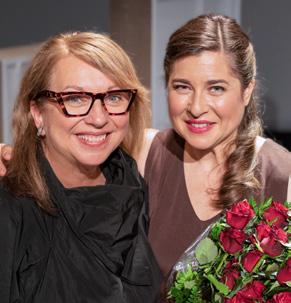
Justice for All continues with Nobel Peace Prize-winner Maria Ressa (May 18), whose date has been rescheduled after her recent triumph in court. Plus, actor, producer and entrepreneur Danny Trejo (Apr 12) will share his spellbinding journey from serving time in San Quentin to becoming a Hollywood hero.
Join Arts & Lectures this spring and be a part of the change we make in the world!
With deepest grat itude,
 Celesta M. Billeci Miller McCune Executive Director
Celesta M. Billeci Miller McCune Executive Director
Arts & Lectures remains committed to addressing issues of social justice. Marking our third season illuminating a wide spectrum of systemic injustice, the Justice for All programming initiative looks to today’s great minds and creators and to the courageous leaders across the globe who are forging a new path forward. Join us as we learn from those confronting uncomfortable questions, solving difficult problems, and guiding us all toward a more equitable world.
May 18
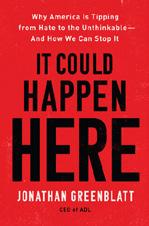

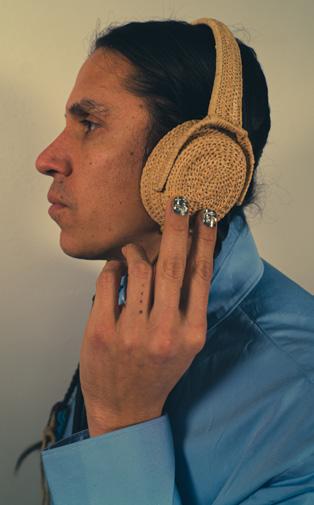
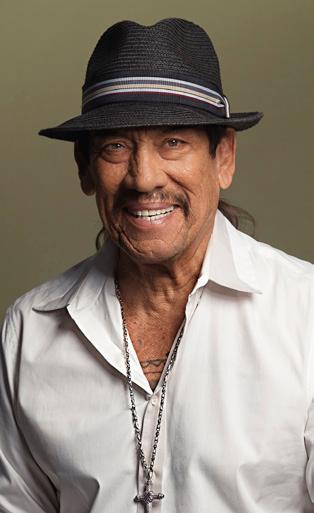
JUSTICE FOR ALL Lead Sponsors: Marcy Carsey, Connie Frank & Evan Thompson, Eva & Yoel Haller, and Zegar Family Foundation
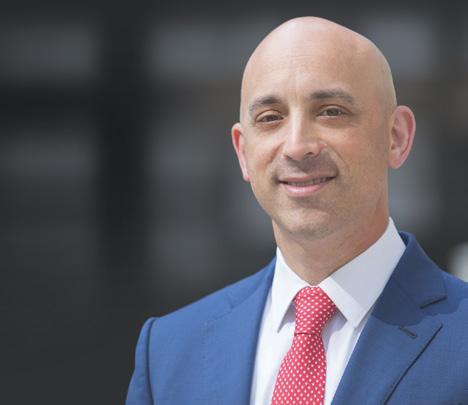
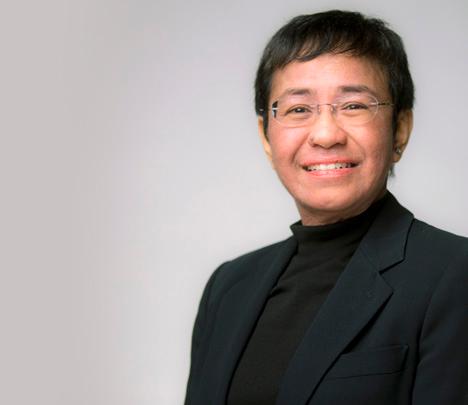
JUSTICE FOR ALL UCSB Faculty Advisory Committee: Gerardo Aldana, Ingrid Banks, Daina Ramey Berry, Charles Hale, Susannah Scott, Jeffrey Stewart, Sharon Tettegah, Kim Yasuda
 Apr 12
Danny Trejo Actor and Champion for Latinx Representation
Apr 19
Nicholas Galanin Indigenous Multimedia Artist
May 9
Woman. Life. Freedom. Public Art Projection
Maria Ressa
Nobel Peace Prize-winner Fighting for Freedom Against Authoritarianism
May 22
Apr 12
Danny Trejo Actor and Champion for Latinx Representation
Apr 19
Nicholas Galanin Indigenous Multimedia Artist
May 9
Woman. Life. Freedom. Public Art Projection
Maria Ressa
Nobel Peace Prize-winner Fighting for Freedom Against Authoritarianism
May 22
At a time of seismic cultural and political shifts, we look to innovators who show us that the impossible is truly attainable. We look to visionaries who point the way toward a peaceful and prosperous future. And we look to those who came before to guide our leaders of tomorrow. Join us as we examine leadership and vision from the personal to the global, to help us move forward with strength, determination and hope.
Calling all poets: In the spirit of National Poetry Month, you’re invited to submit an original poem expressing the qualities of leadership and vision. U.S. Poet Laureate Ada Limón’s “Instructions on Not Giving Up” describes the growth of green leaves in spring as “a return to the strange idea of continuous living despite the mess of us, the hurt, the empty.” Write a poem that inspires you to move forward with strength, determination and hope.
Send your original, unpublished poem to info@ArtsAndLectures.UCSB.edu no later than Friday, April 14 at 5 PM with the subject line #AandLPoetry and indicate your submission level (K-12 or Age 18+).

Prizes include: Your poem published in the Santa Barbara Independent, a copy of Ada Limón’s The Hurting Kind, a $50 Chaucer’s Books gift certificate and a $500 A&L ticket voucher good through 2024.

Arts & Lectures’ Thematic Learning Initiative (TLI) extends the conversation from the stage into the community, enriching lifelong learning and initiating dialogue and empowerment through special events, book giveaways and more.
Film Screening and Conversation with Filmmaker Ramona S. Diaz
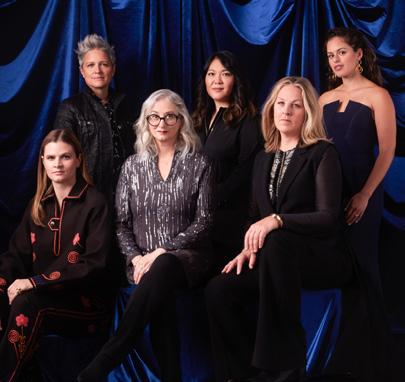
Thu, Apr 20 / 7 PM / UCSB Pollock Theater / FREE (registration recommended at carseywolf.UCSB.edu)
Journalist Maria Ressa and her team at Rappler.com risk their lives and freedom as outspoken critics of Philippine President Rodrigo Duterte’s war on drugs. (Ramona Diaz, 2020, 99 min.)
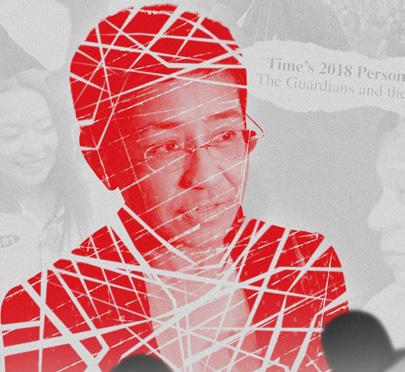
Presented in association with UCSB Carsey-Wolf Center
EVENT Maria
lecture, May 18 / 7:30 PM – note new date (p. 48)
Open Sound Check and
Q&A with ARTEMIS
Sun, Apr 23 / 4 PM / Campbell Hall / FREE (limited availability; registration required at thematic-learning.org)
Blue Note recording ensemble ARTEMIS opens the doors for a behind-the-scenes sound check experience. “What makes ARTEMIS exceptional isn’t how they identify, but how they compose, perform, lead and collaborate as the elite musicians that they are,” writes DownBeat. Watch the masters at work as they prepare for a grooving musical adventure.
RELATED EVENT ARTEMIS performance, Apr 23 / 7 PM (p. 22)
With thanks to our visionary partners, Lynda Weinman and Bruce Heavin, for their support of the Thematic Learning Initiative
RELATED RessaWynton Marsalis, trumpet
Chris Crenshaw, trombone
Abdias Armenteros, saxophone
Chris Lewis, saxophone, clarinet
Carlos Henriquez, bass
Domo Branch, drums
Dan Nimmer, piano
Wynton Marsalis is a world-renowned trumpeter, bandleader, composer and a leading advocate of American culture. He presently serves as managing and artistic director of Jazz at Lincoln Center, director of Jazz Studies at The Juilliard School, and president of the Louis Armstrong Educational Foundation. Born in New Orleans, Louisiana in 1961, he is the son of jazz pianist and music educator Ellis Marsalis, Jr. Marsalis started practicing trumpet at age 6 and grew up playing in an unusually diverse group of musical ensembles, including everything from New Orleans traditional marching bands to funk bands, concert bands, symphonic orchestras and small jazz ensembles. Just one year after moving to New York City to attend The Juilliard School at age 17, Marsalis joined the legendary Art Blakey & The Jazz Messengers.
In 1981, Marsalis formed a quintet and began touring
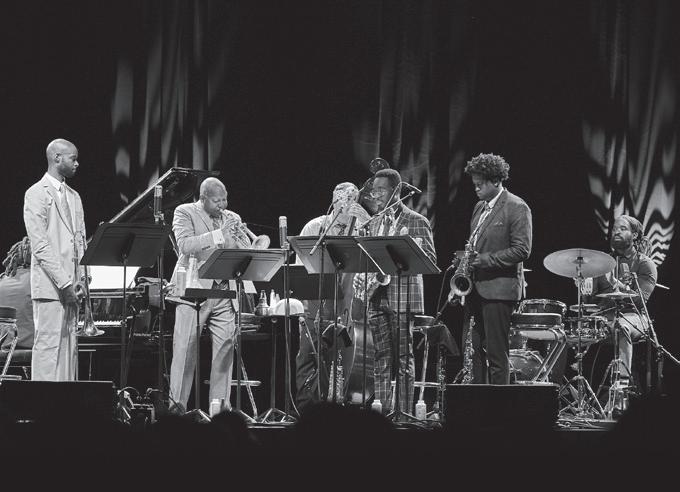
Tue, Apr 4 / 7 PM / Granada Theatre
Program will be announced from the stage
Running time: approx. 75 minutes, no intermission
Major Sponsor: Sara Miller McCune
Event Sponsor: Jody & John Arnhold
Jazz Series Lead Sponsor: Manitou Fund
all over the country and the world. To date, he has performed 4,862 concerts in 856 distinct cities and 65 countries across the globe. Over the past four decades, Marsalis has rekindled and animated widespread international interest in jazz through performances, educational activities, books, curricula and relentless advocacy on public platforms. Today, Marsalis continues the renaissance that he sparked in the early 1980s, attracting new generations of young talent to jazz and illuminating the mythic meanings of jazz fundamentals.
Marsalis has been called the “Pied Piper” of jazz and the “Doctor of Swing.” Since his recording debut in 1982, he has released over 110 jazz and classical recordings and won many awards, from a home cooked meal to honors that require a tuxedo. He regularly performs in the most prestigious concert halls and is known to play til all hours of the morning in the most inconspicuous local clubs. From the very beginning of his career, education has been vital to his mission. He has taught and mentored many, many musicians who have gone on to play, teach and advocate in their own brilliant ways.
Marsalis performs and composes across the entire spectrum of jazz and has written jazz-influenced chamber music and symphonic works for revered classical ensembles across the U.S. and abroad. He is inspired to experiment in an ever-widening palette of forms and concepts that constitute some of the most advanced thinking in modern jazz and in American music on a broad scale. His body of original work includes (but is not limited to) 600 songs and
movements, 11 dance scores, 13 suites, four symphonies, two chamber pieces, two string quartets, a jazz oratorio, a fanfare and concertos for violin and tuba.
Marsalis has received such accolades as the Louis Armstrong Memorial Medal, the French Grand Prix du Disque and the Algur H. Meadows Award for Excellence in the Arts. He was appointed Messenger of Peace by United Nations Secretary General Kofi Annan (2001) and has been awarded The Congressional Horizon Award (2002), the National Medal of Arts (2005) and the National Humanities Medal (2016). Britain’s Royal Academy of Music has granted Marsalis honorary membership; in the fall of 2009, he received France’s highest distinction, the Chevalier of the Legion of Honor. He has received honorary doctorates from 41 of America’s top academic institutions including Harvard, Yale, Princeton and Tulane University in his hometown of New Orleans.
Marsalis is the music’s chief advocate, philosopher and performer who is called upon at ceremonial occasions to place events in their proper historical context. To that end, he is a principal speaker in several vital documentaries on jazz and American culture and has written many relevant essays on jazz-related topics. Between 2011 and 2014, he delivered six groundbreaking and definitive lectures entitled Hidden in Plain View: Meanings in American Music at Harvard University. Marsalis is the author of seven books, including two children’s books.
Marsalis’ core beliefs are based on jazz fundamentals: freedom and individual creativity (improvisation), collective action and good manners (swing), as well as acceptance, gratitude and resilience (the blues). He believes that music has the power to elevate our quality of life and lead us to both higher and lower levels of consciousness. He believes that music can advance the quality of human engagement for individuals, social networks and cultural institutions throughout the world.
Abdias Armenteros is a native of Miami, Florida, where he attended New World School of the Arts High School. He began to play the saxophone at the age of 8 and started to play jazz in the ninth grade. With his acceptance into New World, Armenteros was able to travel to New York City to compete in events like Jazz at Lincoln Center’s Essentially Ellington competition (which the New World jazz band won in 2016). Armenteros was also given the opportunity to travel
internationally to places like Kagoshima, Japan, where he represented the city of Miami and the United States by being part of the only non-Asian group to perform in the Kagoshima Asian Arts Youth Festival. He has also done various summer programs such as the Brubeck Summer Jazz Colony and the Summer Jazz Academy with Jazz at Lincoln Center. Armenteros is currently in the first year of his master’s degree at The Juilliard School as a Jazz Studies major after completing his undergraduate degree at the prestigious institution. Since being in New York, he has shared the bandstand with world-renowned artists like Wynton Marsalis, Ben Vereen, Aloe Blacc, Victor Lewis and Arlo Parks. He performs regularly at some of the top jazz clubs and venues in the city with many other well-known musicians while continuing his studies at Juilliard. Armenteros is a firm believer that music is healing, and we’re living in a time where we need healing the most.
Domo Branch is a bi-coastal drummer, composer and educator from Portland, Oregon. He is the co-owner of Sound Poets Productions with his partner Matt Malanowski. He is the leader of his own band, Branchin’ Out, and is co-leader of the Brown Branch Jazz Orchestra. Since finishing his degree at New York’s Manhattan School of Music, Branch has established himself as one of the world’s top up-and-coming drummers, composers and educators. He has shared the stage and/or toured with prominent artists such as Sean Jones, Stefon Harris, Ron Artis II, Dianne Reeves, Mike Phillips, Terence Blanchard, Taylor Eigsti, Wynton Marsalis and the Jazz at Lincoln Center Orchestra. Branch has performed at a variety of festivals and venues such as Carnegie Hall, Konzerthaus Berlin, Monterey Jazz Festival, Caramoor Jazz Festival, Frederick P. Rose Hall at Jazz at Lincoln Center, and New York’s Jazz Standard.
A graduate of Thomson High School, Valdosta State University and The Juilliard School, Christopher Crenshaw started playing piano at 3 years old and trombone at 11 years old. He grew up playing keyboard with his father Casper in a gospel quartet from Thomson, Georgia, called the Echoes of Joy. He has been with the Jazz at Lincoln Center Orchestra (JLCO) with Wynton Marsalis since 2006 and founded The Georgia Horns in 2011. He’s transcribed music and written arrangements for two Tony Award-nominated
musicals: After Midnight and Shuffle Along. He appears on numerous albums including Marcus Printup’s Ballads All Night, Wynton Marsalis and Eric Clapton Play the Blues, Paul Simon’s In the Blue Light, Ted Nash’s Grammy Awardwinning The Presidential Suite and The Abyssinian Mass. Crenshaw has two albums of his own: The Georgia Horns Live at Dizzy’s Club with Marcus Printup, Thomson native Stantawn Kendrick, Kenny Banks, Jr., Kevin Smith and Brandon McCrae, and Christopher Crenshaw’s The Fifties: A Prism with the JLCO featuring Stantawn Kendrick.
Carlos Henriquez was born in 1979 in the Bronx, New York. He studied music at a young age, played guitar through junior high school and took up the bass while enrolled in The Juilliard School’s Music Advancement Program. He entered LaGuardia High School of Music & Arts and Performing Arts and was involved with the LaGuardia Concert Jazz Ensemble, which went on to win first place in Jazz at Lincoln Center’s Essentially Ellington High School Jazz Band Competition & Festival in 1996. In 1998, soon after high school, Henriquez joined the Wynton Marsalis Septet and the Jazz at Lincoln Center Orchestra, touring the world and being featured on more than 25 albums. Henriquez has performed with artists including Chucho Valdés, Paco de Lucía, Tito Puente, the Marsalis Family, Willie Nelson, Bob Dylan, Stevie Wonder, Lenny Kravitz, Marc Anthony and many others. He has been a member of the music faculty at Northwestern University School of Music since 2008 and was music director of the Jazz at Lincoln Center Orchestra’s cultural exchange with the Cuban Institute of Music with Chucho Valdés in 2010. His debut album as a bandleader, The Bronx Pyramid, came out in September 2015 on Jazz at Lincoln Center’s Blue Engine Records and his most recent album, The South Bronx Story, was nominated for a Grammy.
Grammy Award-winning artist Chris Lewis has quickly established himself as an in-demand saxophonist and music educator. Lewis has played and worked with artists such as Wynton Marsalis, Herbie Hancock, Michael Bublé, Eric Reed, Terell Stafford, the Jazz at Lincoln Center Orchestra, John Beasley’s MONK’estra, the Vanguard Jazz Orchestra, the Mingus Big Band and the Count Basie Orchestra. Lewis has worked on soundtracks and can be seen on camera with shows on Amazon Prime and HBO/CNN Films. In addition, Lewis has taught clinics on small and large ensemble playing,
as well as harmony and improvisation at numerous camps, festivals and universities and has served as a guest clinician for Jazz at Lincoln Center’s Regional Essentially Ellington Festival. Lewis currently resides in New York City where he maintains an active playing and teaching schedule.
Dan Nimmer was born in 1982 in Milwaukee, Wisconsin. As a young man, Nimmer’s family inherited a piano on which he started playing by ear. Nimmer studied classical piano and eventually became interested in jazz. At the same time, he began playing gigs around Milwaukee. Upon graduation from high school, Nimmer left Milwaukee to study music at Northern Illinois University. It didn’t take him long to become one of Chicago’s busiest piano players. Working a lot in the Chicago scene, Nimmer decided to leave school and make the big move to New York City where he immediately emerged on the New York scene. In 2005, a year after moving to New York, he became a member of the Jazz at Lincoln Center Orchestra as well as the Wynton Marsalis Quintet and Septet, all of which he is currently a member. Nimmer has performed and recorded with Jimmy Cobb, Norah Jones, Willie Nelson, Renée Fleming, Houston Person, Fareed Haque, Rubén Blades, Lewis Nash and many more. He has released six of his own trio albums on the Venus label (Japan).
Special Thanks:
Wed, Apr 12 / 7:30 PM / Campbell Hall
Justice for All Lead Sponsors: Marcy Carsey, Connie Frank & Evan Thompson, Eva & Yoel Haller, and Zegar Family Foundation
Presented in association with UCSB Department of Chicana and Chicano Studies
Danny Trejo has developed a prolific career in the entertainment industry with a hard-earned and atypical road to success. From years of imprisonment to helping troubled youth battle drug addictions, from acting to producing, and now on to restaurant ventures, Trejo’s name, face and achievements are recognized in Hollywood and beyond. But it is his continuous role as a devoted father of three and an intervention counselor that bring him the most satisfaction. Trejo has starred in dozens of films including Desperado, Heat, the From Dusk Till Dawn series, Con Air, Once Upon a Time in Mexico, Spy Kids, Machete and Machete Kills. On the television side, Trejo had recurring roles on Sons of Anarchy, King of the Hill, Breaking Bad and The Flash, among others. In the third season of American Gods, Trejo played the character of Mr. World. Most recently, he can be seen in the role of Rancor Keeper in The Book of Boba Fett airing on Disney+.
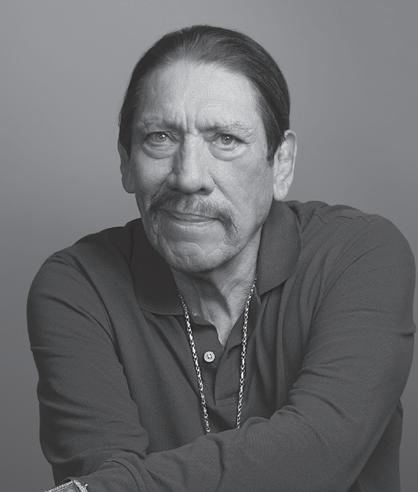
Trejo has starred in and voiced various popular video games like Call of Duty, Fallout, Grand Theft Auto and Def Jam. Additionally, he has voiced characters in the animated films Storks, The Book of Life, Maya and the Three directed by Jorge R. Gutierrez and Minions 2: The Rise of Gru. Trejo’s colorful life and prolific career are chronicled in the bio-documentary Inmate #1, released in 2020. He also published his fearlessly honest memoir Trejo: My Life of Crime, Redemption and Hollywood in July 2021.
Trejo’s expanding restaurant empire includes Trejo’s Tacos and Cantina and Trejo’s Coffee and Donuts. His entrance to the literary world was sharing his love of food in the release of his first cookbook, Trejo’s Tacos: Recipes and Stories from LA. His companion book, Trejo’s Cantina, a book about cocktails, snacks and amazing non-alcoholic drinks from the heart of Hollywood, will be released in April 2023.
Books are available for purchase in the lobby and a signing follows the event
Frederik Øland, violin
Rune Tonsgaard Sørensen, violin
Asbjørn Nørgaard, viola
Fredrik Schøyen Sjölin, cello
Franz Schubert:
String Quartet No. 13 in A minor, D. 804 (“Rosamunde”)
Allegro ma non troppo
Andante
Menuetto. Allegretto – Trio
Allegro moderato
- Intermission -
Franz Schubert:
String Quartet No. 12 in C minor, D. 703 (“Quartettsatz”)
Anna Thorvaldsdottir:
Rituals for String Quartet (U.S. Premiere; Arts & Lectures Co-commission)
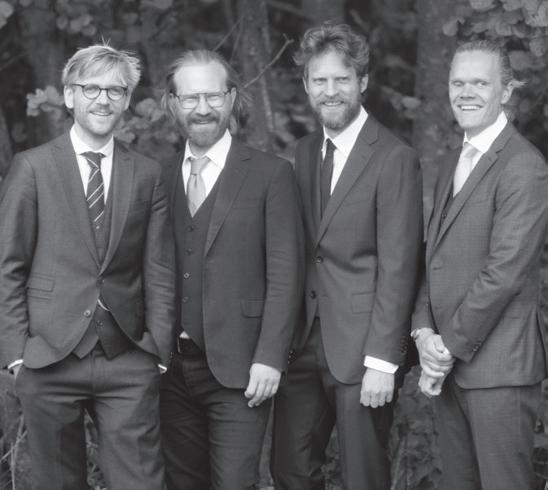
Franz Schubert
(arr. Danish String Quartet): Gretchen am Spinnrade, D.118
Thu, Apr 13 / 7 PM (note special time) / Campbell Hall
Running time: approx. 90 minutes, including intermission
Event Sponsor: Anonymous
Made possible by gifts to the A&L Commission of New Work Endowment Fund
Presented in association with UCSB Department of Music
Franz Schubert (1797-1828):
String Quartet No. 13 in A minor, D. 804 (“Rosamunde”)
Soon after his 26th birthday, Franz Schubert made the first known mention of the disease that would claim his life just five years later. An otherwise unremarkable letter opens with this portentous sentence: “Kindly forgive me if I am compelled to inconvenience you with another letter so soon, but the circumstances of my health still forbid me to leave the house.” Though unnamed by Schubert, most scholars agree that the disease was in fact syphilis. He soon began experiencing symptoms characteristic of secondary syphilis including painful rashes and hair loss; the latter forced him to shave his head and don a wig. Within a year he was suffering from oral lesions, aching bones, wracking headaches and a pain in his left arm so intense that for a time he was unable to play the piano. Though easily curable today, in Schubert’s time syphilis was effectively a death sentence; patients usually had three to ten years before the onset of tertiary – and often terminal – symptoms.
Schubert’s writing from this gloomy time sheds light on the inner turmoil of a young man at the height of his powers yet living on borrowed time. One stanza from a rare poem Schubert composed shows a glimpse into his agony: “See, annihilated I lay in the dust, / Scorched by agonizing fire, / My life’s martyr path, / Approaching eternal oblivion.” Shortly after completing
his Thirteenth and Fourteenth String Quartets in March 1824 he wrote to a friend,
“I find myself to be the most unhappy and wretched creature in the world. Imagine a man whose health will never be right again, and who in sheer despair continually makes things worse and worse instead of better; imagine a man, I say, whose most brilliant hopes have perished… and I ask you, is he not a miserable, unhappy being?”
The letter continues with a quotation from Gretchen am Spinnrade (Gretchen at the Spinning Wheel), a song Schubert had composed nearly a decade earlier. The title character, the heroine of Goethe’s epic Faust, comes to ruin after her seduction by Faust and the diabolical Mephistopheles. Schubert quotes the opening stanza in which Gretchen laments, “My peace is gone, my heart is heavy, I shall find it nevermore.” Schubert alludes to both Gretchen and another song in the first and third movements of the “Rosamunde” Quartet, imbuing the work with added layers of melancholy and nostalgia.
The quartet gets its nickname from the main theme of the second movement, which Schubert based on a theme from incidental music he composed for the play Rosamunde, Princess of Cyprus the year before. Though the play ran for only two performances, the music was an instant success. The text of Rosamunde is now lost, though Schubert’s score was discovered decades after his death tucked away in a cupboard in Vienna.
The main theme of the first movement opens with a descending triad; the very gesture suggests exhaustion. In contrast, the driving rhythm in the lower voices provides a continuous thrum of energy. While Rosamunde gives the quartet its sobriquet, the opening figure in the second violin resembles the piano accompaniment in Gretchen am Spinnrade, itself a sonic evocation of the titular spinning wheel. Galloping triplets in the third section and the dramatic final bars call to mind the galloping horse in Erlkönig, another of Schubert’s early Goethe settings.
Much of the second movement, a tender yet intensely chromatic Andante, is quite soft: save for a few clamorous outbursts the dynamics are predominantly piano and pianissimo. Some scholars have noted the resemblance between the five-note rhythm introduced by the first violin to a rhythm found in the Allegretto of Beethoven’s Seventh Symphony, which premiered in Vienna a decade before Schubert composed
this quartet. Any resemblance to the Seventh notwithstanding, Schubert’s ability to make extensive use of a simple rhythmic gesture calls to mind another work by his idol: the first movement of Beethoven’s Fifth Symphony.
In the third movement, a rueful minuet and trio, Schubert again alludes to one of his earlier works. The dotted three-note figure permeating the movement comes from his 1819 song Die Götter Griechenlands. Its text, by poet Friedrich Schiller (of “Ode to Joy” fame), speaks longingly of a distant past: “Fair world, where are you? Return again, / sweet springtime of nature! / Alas, only in the magic land of song / does your fabled memory live on.”
In contrast to the somber air pervading the oddnumbered movements, the mood of the fourth and final movement is one of cautious optimism. Highflying virtuosity and a delightful call-and-response between instruments imbue the finale with a cheeriness belying the turmoil that preceded it.
Program note © Andrew McIntyre, 2023
String Quartet No. 12 in C minor, D. 703, (“Quartettsatz”)
When Schubert composed this quartet movement in late 1820, he was unplagued by the darkness surrounding the composition of the “Rosamunde” Quartet. While he wasn’t yet a financially independent composer, he seemed on the verge of a breakthrough. In April 1821 Schubert published his first compositions, the songs Erlkönig and Gretchen am Spinnrade. A local opera company invited Schubert to write a new work. The Gesellschaft der Musikfreunde, a society whose members would eventually include Johannes Brahms and Gustav Mahler, invited Schubert to join them after rejecting his application three years earlier. Vienna saw a rapid increase of performances of his vocal music, including the first documented Schubertiad, informal gatherings of Schubert’s friends and admirers (and often the composer himself) to perform his music. By the following year he had finally earned enough money from his publications to support a modest living. Despite the four-year gap between his eleventh quartet and the arrested attempt at a twelfth, Schubert continued composing at a dizzying rate. His output from those years includes piano sonatas (seven in 1817 alone); his Sixth Symphony; numerous songs including Der Tod und das Mädchen, An die Musik, and Die Forelle; and the famous “Trout” Quintet, which
uses the melody of Die Forelle in a set of variations. Three more years would pass between the writing of the “Quartettsatz” and the Thirteenth and Fourteenth Quartets. These too were prolific, resulting in the completion of a monumental Mass, a new opera, even more songs, the rhapsodic “Wanderer” Fantasy for solo piano and a small request for a variation on a waltz theme composed by one of his publishers, Anton Diabelli. The dramatic opening of the “Quartettsatz” includes several elements from the proto-Romantic Sturm und Drang movement: sudden dynamic and key changes, trembling strings and a strong, propulsive rhythm. In contrast to the stormy opening, much of the major-key exposition is played softly and sweetly. The opening material bookends the movement, making a surprise reapparance in the final bars of the coda. In addition to the complete movement performed here, Schubert wrote out the exposition of a slow second movement before abandoning the work. While scholars have speculated as to why Schubert failed to finish the quartet, they generally agree that the existing music reveals a maturation of the composer’s style. Schubert had written many of his earlier quartets for informal performances by himself, his father and his brothers. Greater independence between voices and the virtuosic nature of the music, including swift threeoctave runs in the first violin, suggest that this quartet was intended for a more polished ensemble.
Program note © Andrew McIntyre, 2023
My music emerges as a stream of consciousness that flows, is felt, sensed, shaped and then crafted, it does not emerge from a verbal place – but when a piece is completed I often spend quite a bit of time finding ways to articulate some of the important elements of the musical ideas or thoughts that play certain key roles in the origin of the piece – with Rituals however the accompanying text needed to be left impressionistic and unfiltered.
As with my music generally, the thoughts and ideas associated with the origin or development of a piece is not something I am trying to describe through the music – it is a way to intuitively approach and work with the core energy, structure, atmosphere and material of the piece.
Repetition in atmosphere – going through motions, the same motions, but it is never the same – with every
repeating breath is a new feeling, new vision, new life, new being, same life – the same but always different –various perspectives of ritualistic feelings, sensations, explorations, from the hymn-like Ascension to obsessive percussive materials… from parts that move like a rigorous engine to others of flowing atmospheric ether – but all have in common the ritualistic approach to the material – rituals in lyricism – rituals in hope –rituals in repetition – rituals in song – rituals in material – rituals in prayer – rituals in obsession – rituals in life –rituals in being – rituals in harmonies – bending rituals – rituals in difference – ritual as an escape – ritual as peace – ritual as continuation – ritual as burden – ritual as hope – ritual as obsession – ritual as being – ritual in harmony – each part is its own ritual and together the eleven parts form one ritual.
– Anna ThorvaldsdottirFranz Schubert (1797-1828): Gretchen am Spinnrade, D. 118, arranged by the Danish String Quartet
Schubert was a prolific composer whose songs –over 600 of them – encompass some of the greatest poetry of the Romantic era. While Schubert set nearly 90 authors to music, he held an affinity for Johann Wolfgang von Goethe, setting over seventy of Goethe’s texts.
Though contemporaries, the two never met. When Schubert was nineteen, one of his friends sent a collection of Schubert’s songs (including Gretchen am Spinnrade) to the poet, which went unanswered. A decade later, Schubert himself would write to Goethe with a dedication; this too failed to garner a response. Though Goethe was fifty years Schubert’s senior, he ultimately outlived the composer.
The pairing of Schubert’s music with Goethe’s words was celebrated in their lifetimes; one eager journalist wrote, “Goethe and Schubert! Oh happy bond, to Germany’s eternal fame!” This prolific marriage of tune and text began when the seventeen-year-old Schubert first encountered Faust, Goethe’s magnum opus and one of the crowning achievements of all of German literature. By this point Schubert had already written his First Symphony and was at work on his Second, yet his ambitions of becoming a celebrated composer seemed distant. That autumn, he had taken a position as his father’s teaching assistant, a role which by all accounts he was uninterested in and ill-suited for. Yet Goethe’s verses ignited a fire within Schubert that led to one of the most fruitful periods of composition in musical
history. He composed Gretchen am Spinnrade on a single day in October 1814; five additional songs with texts by Goethe followed within the year, and in 1815 alone he composed over 20,000 bars of music.
The song opens with a hypnotic, repetitive pattern in the piano that evokes Gretchen’s spinning wheel. As the wheel turns incessantly, Gretchen sings of Faust in impassioned and obsessive phrases. The music swells in intensity, the spinning wheel whirling ever faster until all comes to a halt at the memory of Faust’s kiss. After a couple sputtering attempts the wheel begins again before building to an even greater climax. The song ends with one last despairing refrain of the opening line: “My peace is gone, my heart is heavy.”
Gretchen am Spinnrade has become not only one of Schubert’s most enduring compositions but a turning point in the history of Western music. Along with Schubert’s other Goethe songs, Gretchen elevated the stature of German art song (Lieder), which had before been considered a minor genre.
The Danish String Quartet celebrates its 20th anniversary in 2022-2023, and the Grammy-nominated quartet continues to assert its preeminence among the world’s finest string quartets. Formed when they were in their teens, they are renowned for impeccable musicianship, sophisticated artistry, exquisite clarity of ensemble and, above all, and an unmatched ability to play as one. Performances are characterized by a rare musical spontaneity, giving audiences the sense of hearing even treasured canon repertoire as if for the first time. They exude a palpable joy in musicmaking that has made them one of today’s most highly acclaimed and in-demand classical quartets, performing in sold-out concert halls around the world. Their inventive and intriguing programming and repertoire choices have produced critically-acclaimed original projects and commissions as well as popular arrangements of Scandinavian folk music.
This season, the Danish String Quartet continues its Doppelgänger series, an ambitious four-year international commissioning project. Doppelgänger pairs world premieres from four renowned composers –Bent Sørensen, Lotta Wennäkoski, Anna Thorvaldsdottir and Thomas Adès – with late major chamber works by Schubert. Each season, the Quartet performs a
world premiere on a program with its doppelgänger – the Schubert quartet or quintet that inspired it –culminating in 2024 in the premiere of a quintet by Adès, after the String Quintet in C Major. This season’s new work, by Anna Thorvaldsdottir, premieres in April 2023 and is paired with Schubert’s String Quartet in A Minor, “Rosamunde.” The Doppelgänger pieces are commissioned by the Danish String Quartet with the support of Carnegie Hall, Cal Performances, UC Santa Barbara Arts & Lectures, Vancouver Recital Society, Flagey in Brussels, and Muziekgebouw in Amsterdam. The Quartet performs 28 concerts in North America this season over the course of three separate tours. Additionally, they are Artist in Residence at London’s Wigmore Hall.
The Danish String Quartet’s most recent recording project is Prism, a series of five discs on ECM New Series that explores the symbiotic musical and contextual relationships between Bach fugues, Beethoven string quartets and works by Shostakovich, Schnittke, Bartók, Mendelssohn and Webern. Four of the five recordings have been released on ECM, and the fifth, Prism V, is slated for 2023. The recently-released Prism IV (2022) was an Editor’s Choice in Limelight magazine. The Quartet’s discography reflects the ensemble’s special affinity for Scandinavian composers, with the complete quartets of Carl Nielsen (DaCapo, 2007 and 2008) and Adès/Nørgård/Abrahamsen, their debut on ECM in 2016. They also released two discs of traditional Scandinavian folk music, Wood Works (Dacapo, 2014) and Last Leaf (ECM, 2017), which was one of the top classical albums of the year, as chosen by NPR, Spotify and The New York Times, among others. A third folk recording is planned for release in 2023 on ECM.
The Quartet takes an active role in reaching new audiences through special projects. In 2007, they established the DSQ Festival, which takes place in intimate and informal settings in Copenhagen. In 2016, they inaugurated a concert series, Series of Four, in which they both perform and invite colleagues to appear.
They are the recipients of many awards and prestigious appointments, including Musical America’s 2020 Ensemble of the Year and the Borletti-Buitoni Trust. The Quartet was named in 2013 as BBC Radio 3 New Generation Artists and appointed to The Bowers Program (formerly CMS Two). The Quartet was the awarded the 2010 NORDMETALL-Ensemble Prize at the Mecklenburg-Vorpommern Festival in Germany, and in 2011, they received the Carl Nielsen Prize, the highest cultural honor in Denmark.
Program note © Andrew McIntyre, 2023Violinists Frederik Øland and Rune Tonsgaard Sørenson and violist Asbjørn Nørgaard met as children at a music summer camp where they played soccer and made music together. As teenagers, they began the study of classical chamber music and were mentored by Tim Frederiksen of Copenhagen’s Royal Danish Academy of Music. In 2008, the three Danes were joined by Norwegian cellist Fredrik Schøyen Sjölin.
www.danishquartet.com
Exclusive Representation: Kirshbaum Associates Inc.
307 Seventh Avenue, Suite 506 New York, NY 10001
www.kirshbaumassociated.com
The Danish String Quartet is currently exclusive with ECM Records and has previously recorded for DaCapo and Cavi-Music/BR Klassik
Rituals is commissioned by the Danish String Quartet with the support of Carnegie Hall, Cal Performances, Vancouver Recital Society, UC Santa Barbara Arts & Lectures, Washington Performing Arts, Flagey and Muziekgebouw aan’t IJ
Special Thanks
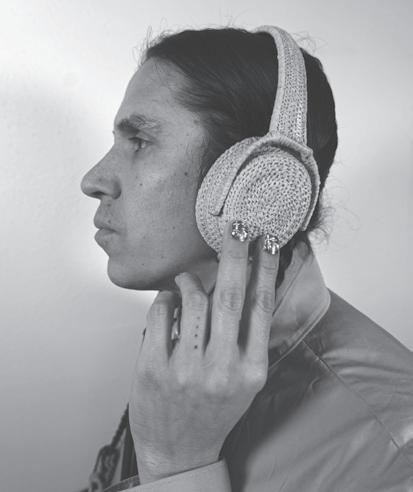
Wed, Apr 19 / 7:30 PM / Campbell Hall
Justice for All Lead Sponsors: Marcy Carsey, Connie Frank & Evan Thompson, Eva & Yoel Haller, and Zegar Family Foundation
Presented in association with the following UCSB partners: Department of Art, and the Office of Diversity, Equity, and Inclusion
Nicholas Galanin’s work is rooted in his perspective as an Indigenous man connected to the land and culture he belongs to. His work is embedded with incisive observation and critical thinking to advocate social and environmental justice. Galanin’s work expands and refocuses the intersections of culture, centering Indigeneity through concept, form, image and sound. His works are vessels for knowledge, culture and technology – inherently political, generous, unflinching, insistent and poetic.
Deftly engaging with past, present and future, Galanin celebrates the beauty, knowledge and resilience of Indigenous people. His work counters assimilation; insisting on differences as strengths. Rejecting binaries and categorization, Galanin works to envision, build and support Indigenous sovereignty.
Over the past two decades his work has ranged across media, materials and processes; in which Galanin has splintered tourist industry replica carvings into pieces, the rearranged pieces evidence the damage of commodification to culture through photos, objects and video. His practice includes customary cultural objects, petroglyphs in sidewalks and coastal rock, masks cut from anthropological texts, and a taxidermied polar bear melting into a pool of it’s own fur. In 2020 Galanin excavated the shape of the shadow of the Captain James Cooke statue in Hyde Park for the Biennale of Sydney, examining the effects of colonization on land, critiquing anthropological bias and ultimately suggesting the burial of the statue
and others like it. In 2021 he created a replica of the Hollywood sign for the Desert X Biennial in Palm Springs, which reads INDIAN LAND, directly advocating for and supporting the Land Back and Real Rent initiatives. Galanin holds a BFA from London Guildhall University in Jewelry Design and an MFA in Indigenous Visual Arts from Massey University in New Zealand, prior to which he apprenticed with master carvers and jewelers in his community. He is represented by Peter Blum Gallery in New York, and his music is released by Sub Pop Records in Seattle. Galanin lives and works with his family on Lingít Aani, Sitka, Alaska.
Eric Cha-Beach: 4+9 (2017)
Angélica Negrón: gone (2018)
Angélica Negrón: go back (2022)
Nathalie Joachim: Note to Self (2021)
Much More
Maybe
Motivated
- Intermission -
Sō Percussion and Caroline Shaw: Let the Soil Play its Simple Part (2020)
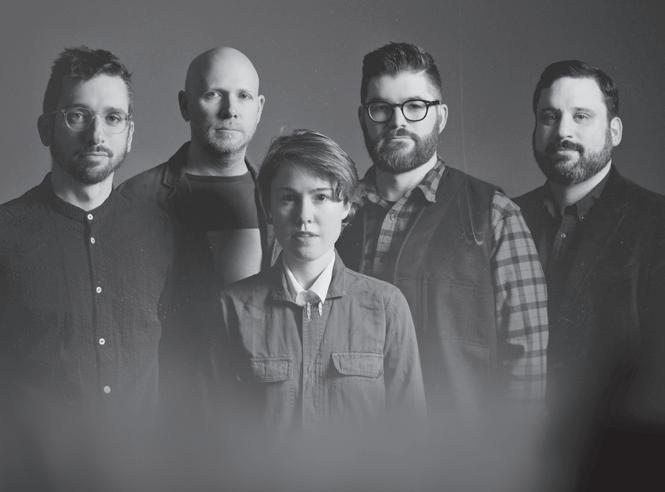
To the Sky
The Flood Is Following Me
Let the Soil Play Its Simple Part
Long Ago We Counted
A Gradual Dazzle
Lay All Your Love
Cast the Bells in Sand
Some Bright Morning
A Veil Awave Upon the Waves
Other Song
Fri, Apr 21 / 8 PM / Campbell Hall
Running time: approx. 105 minutes, including intermission
Presented in association with UCSB Department of Music
Eric Cha-Beach (b. 1982): 4+9
4+9 was written for the Sō Percussion Summer Institute 2017. The piece explores all of the ways that a bar of 9/4 can be subdivided: There are 36 sixteenth notes in the bar (9 beats x 4 sixteenth notes per beat) – and 36 can be divided evenly by 2, 3, 4, 6, 9, 12 and 18. The various combinations of different overlapping divisions in the bar make the underlying groupings of 16th notes constantly sound different. I used this basic idea in a piece for Sō Percussion’s project “A Gun Show” in 2016, but 4+9 explores simply the pure process of hearing each possible combination in turn.
– Eric Cha-BeachAngélica Negrón (b. 1981): gone and go back gone and go back are two short pieces written for Sō Percussion as part of a three-part series inspired by things I deeply care about but am sometimes afraid to confront. Each piece in the series focuses on the quartet’s interactions with a series of mechanical instruments built by Brooklyn-based artist and engineer Nick Yulman. Yulman’s sound machines (called the Bricolo Mechanical Music System) consist of a variety of mechanical modules that users can attach to acoustic instruments or physical objects, allowing digital music makers to incorporate robotics into their performance and recording setups. Each piece requires the
performers to interact with the modular music devices in different ways.
The first piece in this series, titled gone, was written in 2018 and explores the visceral, physical feeling of emptiness and absence while at the same time searching for connections and meaning in those things and people that are left. The second piece, titled go back, written in 2022, confronts the anxiety and internal conflict I have around the idea of returning to my home of Puerto Rico. I’ve been living in New York for the past 15 years and though I’m constantly traveling back to the island to visit family and friends, for the past few years there seems to be a growing imminent pressure and almost impulsive need to return home. Parents getting older, close friends returning to the island and raising their new families as well as a new wave of young Diasporicans returning to contribute to rebuilding the island after the many natural disasters and social and political crises including disaster capitalism. Circular migration has long been a part of the Puerto Rican narrative and over the past few years I’ve been struggling constantly with the simultaneous conflicting desire to come back to the island, a growing duty to participate in the local fight, an increasing yearning to be close to my loved ones and the difficult realization that this might not be the best decision for me at this point in my career and in my life.
go back uses cacerolas and calderos (pots and pans) in Yulman’s mechanical modular devices to evoke the domestic sounds of my childhood as well as the sounds of resilience and resistance that characterize many of the protests on the island as well as in the diaspora as a particular form of sonic protest known as “cacerolazo.”
– Angélica NegrónCommissioned for Sō Percussion
Though I’ve spent much of my life trying to quiet my inner voice, for this work, I chose to focus on and explore the thoughts that occupy my headspace as a result of my chronic anxiety. Note to Self, for percussion quartet and recorded samples of my voice, takes the listener through different phases of cyclical thoughts and states of being that I experience regularly. Composed in three short movements – Much More, Maybe and Motivated – this work examines the notion of having my inner voice embodied elsewhere, in an attempt to create new space for processing emotion.
It also plays with repetition as an opportunity to bring new meaning, understanding and perhaps some levity to the language itself. Each movement is a reimagining of vocal incantations that, driven by imaginative, virtuosic and whimsical percussion scoring, re-center and re-purpose my voice as a tool for healing.
– Nathalie Joachim
This work was co-commissioned for S ō Percussion by Andrew W. Siegel and Carnegie Hall. The World Premiere was given by S ō Percussion in Zankel Hall, Carnegie Hall, New York City, on December 11, 2021.
Caroline Shaw and Sō Percussion combine forces for a powerful new original set of songs composed together. Shaw’s faultless ear for melody and harmony, combined with Sō’s rhythmic invention and compositional experimentation, make for a world of sonic richness that feels fresh and unique. It is a journey across the landscape of the soul, told through the medium of distinctly contemporary songs which represent Shaw’s debut as a solo vocal artist.
Shared lifetimes of voluminous musical and literary experiences traverse the spiritual realms of the Sacred Harp and the Book of Ruth; the oceanic ruminations of James Joyce; the American roots song “I’ll Fly Away” filtered through medieval plainchant; and even the pop group ABBA. Sonically, there is no other collaboration to compare it to. Shaw’s voice cycles from the gently intimate, to penetrating rapture, through layers of constructed counterpoint, while Sō Percussion’s nearly endless menagerie of instruments and techniques provides varying accompaniments of drums, piano, marimba, steel drums, electronics, tuned flower pots, toys, synthesizers and much more.
The thrill in this collaboration lies partly in the sense that each entity adds dimensions to the other’s music which revitalizes them both. Shaw gives voice and melody to the years of experimentation in rhythm, color and complexity which defines Sō’s work over two decades and more than 20 albums. Sō opens a world of sonic possibilities and rhythmic virtuosity which dramatically expands Shaw’s palette beyond the vocal and string writing which she is best known for.
In this collection of 10 songs, forces alternate between tightly-crafted orchestrations and spontaneous duets with Shaw and each of the four members of Sō Percussion. The title song of the set features Shaw’s
unadorned voice setting her own words, accompanied by Josh Quillen’s lyrical strumming on the steel drums. In Lay All Your Love On Me, Shaw and Adam Sliwinski concoct a stately motet for voice and marimba out of the chorus from ABBA’s famous hit song. In Long Ago We Counted, Jason Treuting unleashes cascades of his signature drumming underneath otherworldly loops of Shaw’s voice. With Some Bright Morning, Eric Cha-Beach simmers various layers of ambient drones under Shaw’s gradually unfolding synthesis of I’ll Fly Away and the 13th-century plainchant Salve Regina.
Other songs build layers of instrumentation as blocks of rhythm and sound underneath Shaw’s voice. Find the Line announces itself with a progression of flower pot harmony, which builds surprisingly into an uplifting, anthemic celebration of life and devotion. Two songs take their titles from lines in James Joyce’s Ulysses: The Flood Is Following Me and A Veil Upon the Waves. Both are thick with layers of ambivalence and reflection. Soon Our Transient Comforts Fly builds interlocking rhythms reminiscent of Steve Reich, which Shaw elevates with a yawp of spiritual ecstasy from the Sacred Harp tradition.
Eric Cha-Beach
Josh Quillen
Adam Sliwinski
Jason Treuting
For twenty years and counting, Sō Percussion has redefined chamber music for the 21st century through an “exhilarating blend of precision and anarchy, rigor and bedlam” (The New Yorker). They are celebrated by audiences and presenters for a dazzling range of work: for live performances in which “telepathic powers of communication” (The New York Times) bring to life the vibrant percussion repertoire; for an extravagant array of collaborations in classical music, pop, indie rock, contemporary dance and theater; and for their work in education and community, creating opportunities and platforms for music and artists that explore the immense possibility of art in our time.
Recent highlights have included performances at the Elbphilharmonie, Big Ears 2022 – where they performed Amid the Noise, premiered a new work by Angélica Negrón with the Kronos Quartet, and performed their Nonesuch album with Caroline Shaw, Let the Soil Play Its
Simple Part – and a return to Carnegie Hall where they presented new collaborations with Nathalie Joachim and Dominic Shodekeh Talifero. Their Nonesuch recording Narrow Sea, with Caroline Shaw, Dawn Upshaw and Gilbert Kalish, won the 2022 Grammy for Best Composition. Other recent albums include A Record Of… on Brassland Music with Buke and Gase, and – on new imprint Sō Percussion Editions – an acclaimed version of Julius Eastman’s Stay On It and Darian Donovan Thomas’ Individuate. This adds to a catalog of more than 25 albums featuring landmark recordings of works by David Lang, Steve Reich, Steve Mackey and many more.
In the summer of 2022, Sō performed at the Music Academy of the West Summer Festival, Newport Classical, Time Spans in New York, and offered four concerts at Our Festival in Helsinki – including a performance of Let the Soil with Caroline Shaw. 20222023 dates include concerts at Cal Performances, the Palau de la Música Catalana in Barcelona, the Barbican in London, Kennedy Center for the Performing Arts, Penn Live Arts in Philadelphia, University of North Carolina, Chapel Hill and at The 92nd Street Y, New York.
In fall 2022, Sō Percussion began its ninth year as the Edward T. Cone performers-in-residence at Princeton University. Rooted in the belief that music is an elemental form of human communication, and galvanized by forces for social change in recent years, Sō enthusiastically pursues a range of social and community outreach through their nonprofit organization, including partnerships with local ensembles such as Pan in Motion and Castle of Our Skins; their Brooklyn Bound concert series; a studio residency program in Brooklyn; and the Sō Percussion Summer Institute, an intensive two-week chamber music seminar for percussionists and composers.
Caroline Shaw is a New York-based musician – vocalist, violinist, composer and producer – who performs in solo and collaborative projects. She was the youngest recipient of the Pulitzer Prize for Music in 2013 for Partita for 8 Voices, written for the Grammy-winning Roomful of Teeth, of which she is a member. Recent commissions include new works for Renée Fleming with Inon Barnatan, Dawn Upshaw with Sō Percussion and Gil Kalish, Seattle Symphony, Anne Sofie von Otter with Philharmonia Baroque, the Los Angeles Philharmonic, Juilliard 415, the Orchestra of St. Luke’s
with John Lithgow, the Dover Quartet, TENET, The Crossing, the Mendelssohn Club of Philadelphia, the Calidore Quartet, Brooklyn Rider, the Baltimore Symphony and Roomful of Teeth with A Far Cry. Shaw’s film scores include Erica Fae’s To Keep the Light and Josephine Decker’s Madeline’s Madeline as well as the upcoming short 8th Year of the Emergency by Maureen Towey. She has produced for Kanye West (The Life of Pablo; Ye) and Nas (NASIR), and has contributed to records by The National and by Arcade Fire’s Richard Reed Parry. Once, she got to sing in three-part harmony with Sara Bareilles and Ben Folds at the Kennedy Center, and that was pretty much the bees’ knees and elbows. Shaw has studied at Rice, Yale and Princeton universities, currently teaches at New York University and is a creative associate at The Juilliard School. She has held residencies at Dumbarton Oaks, the Banff Centre, Music on Main and the Vail Dance Festival. She loves the color yellow, otters, Beethoven opus 74, Mozart opera, Kinhaven, the smell of rosemary and the sound of a janky mandolin.
Sō Percussion’s 2022-2023 season is supported in part by awards from:
The National Endowment for the Arts
To find out more about how National Endowment for the Arts grants impact individuals and communities, visit www.arts.gov
The New York State Council on the Arts with the support of Governor Kathy Hochul and the New York State Legislature
The New York City Department of Cultural Affairs in partnership with the City Council
The Aaron Copland Fund for Music
The Alice M. Ditson Fund of Columbia University
The Amphion Foundation
The Brookby Foundation
The Gladys Krieble Delmas Foundation
The Fan Fox and Leslie R. Samuels Foundation
The Howard Gilman Foundation
The Mid Atlantic Arts Foundation
Sō Percussion uses Vic Firth sticks, Zildjian cymbals, Remo drumheads, Estey Organs, and Pearl/Adams instruments. Sō Percussion would like to thank these companies for their generous support and donations.
Sat, Apr 22 / 7 PM (note special time) / Campbell Hall
Program will be announced from the stage Running time: approx. 120 minutes, including intermission
Peter Brooke Turner, soprano ukulele
Laura Currie, concert ukulele
Dominic Howles, bass ukulele
Leisa Rea, soprano ukulele
Ben Rouse, tenor ukulele
Chris Walker, concert ukulele
Ewan Wardrop, baritone ukulele
Musical Director: George Hinchliffe
Tour Management: Viola Farrington
Sound: Verena Rogler
The Ukulele Orchestra (Ukes) is a touring musical group which has been delighting audiences, raising the roof, selling out performances and receiving standing ovations since 1985. This all-singing, all-strumming group has been performing for 38 years using only a fistful of ukuleles and maintaining that all genres of music are available for reinterpretation.
The premise sounds astoundingly simple: instruments, voices, no gimmicks, no light show. Yet The New York Times exclaims that “they extract more than seems humanly possible from so small and so modest an instrument.”
As soon as the performers walk on stage, the audience feels that they are in safe hands, at home with friends who are totally in command of the art, craft and magic of the stage. Sitting in chamber group format and dressed in formal evening wear (regardless of the time of day or the venue, whether Glastonbury Festival or Carnegie Hall), it uses the limitations of the instrument to create a musical freedom as it reveals unsuspected musical insights. At this point, the audience may well sit back, all prior assumptions forgotten, and allow the orchestra, which has changed the face of the ukulele
world, to give what the Independent raved as “the best musical entertainment in the country.”
The first gig, intended as a one-off bit of fun, was an instant sell-out and led to national radio, television, album recordings and international tours. Since then, the orchestra has become what the Observer called “a much loved institution” giving thousands of concert, television and radio appearances all over the world. There have been tours in Britain, across Europe, Scandinavia, New Zealand, Australia, Japan, China, the U.S., Canada and the North Pole. They also had the honor to perform, by invitation of The Prince of Wales, at the private 90th birthday party of Her Majesty Queen Elizabeth II at Windsor Castle.
The Ukulele Orchestra have released CDs and DVDs on their own independent label. The orchestra’s music has been used in films, plays and commercials. The Financial Times proclaimed “the sophisticated sound they make – both percussive and melodic – is at once hilarious and heartfelt.”
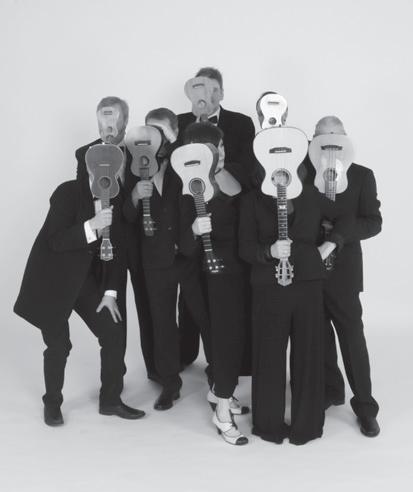
At over two meters tall, Peter Brooke Turner may well be the tallest ukulele player in the world – he is certainly the tallest in the Ukulele Orchestra. He was born in Portugal and grew up in the Soviet Union, Brazil, the U.S., Finland and Italy. After false starts on the violin, trumpet and guitar, he finally discovered the ukulele and joined the Ukes in 1995. He has released three albums under his pseudonym Tony Penultimate and has worked with
many well-known showbiz names in the U.K. He fronted his own Ukulele Kings rock group in the 1990s. Turner started the world’s first high-altitude drama company – the ATTC (Airline Toilets Theatre Company) which has subsequently produced more than 20 high-quality, low-budget songs, sketches and shows (all on Turner’s iPhone) from this oft-neglected performance area. They can be viewed online.
The youngest member of the orchestra, Laura Currie was born in Dumfries, Scotland, and studied English Literature at the University of Edinburgh. She started playing the ukulele at the age of fifteen after seeing the Ukes in concert and used the instrument to front her first rock band at sixteen years old. She began performing with the Ukes in 2019, and has since toured with them across China, France and Switzerland. When not touring with the orchestra, Currie performs under the solo stage name Ra. She writes and releases original songs and covers, and one of her collaborative singles was recently featured in a Netflix show. Currie has garnered an active online following for her eclectic mix of elaborately self-produced YouTube videos. During the COVID-19 lockdown in the U.K., she used these video editing skills to produce the Ukulele Lockdown series that the Ukes released weekly on YouTube. Currie also plays piano, bass and guitar.
Dominic Howles grew up in Jamaica, Hong Kong and Somerset. He is a very experienced bass player, using double bass and electric bass, and has worked with many well-known jazz names and in classical ensembles. He has worked with Tommy Chase, Stacey Kent, Bobby Wellins, Don Weller, Julian Siegel and many others. He studied at the Guildhall School of Music and Drama and has performed in Europe, the Middle East and Asia, and on television, radio and theater. He has undertaken, directed and written multimedia work, and is well-respected as a composer and arranger. His own groups have performed successfully for many years. He is a first-class bass soloist and has an engaging sense of humor, which is – ahem – always useful when working with ukulele players. He lives in London.
Leisa Rea has a background in theater, comedy, writing and music. She’s worked as an actor and director, written for stage, television and radio, and has played with the Ukes for the past 15 years. She has taught stand-up comedy, written for the BAFTA-nominated series Miranda (BBC), performed in her own criticallyacclaimed shows and was the winner of the inaugural Musical Comedy Awards in 2009. Away from orchestral duties, Rea brings her considerable experience as
a performer and artist to people all over the world through her online ukulele teaching and workshops. Recently, she won an Arts Council of England grant to allow her to train as an audio digital producer.
Ben Rouse was born in Cornwall but grew up in Hampshire. At the age of 8 he began playing the drums, turning to the guitar at age 11. At 23, Rouse formed the rock band Purple Monkey, which became a popular band along the south coast of England. At 25, he decided to learn the violin and mandolin and formed the folk duo Teapot Junkies, releasing two albums of original material. He went on to teach himself the saxophone, flute, trumpet and banjo. At 30, Ben decided that a proper job might be necessary and earned himself an HND in electronics, but in 2007 was drawn back to music when he saw the Ukulele Orchestra perform on Jools Holland Hootenanny. The next day he bought a ukulele and began performing and teaching workshops at festivals around the U.K. until, in 2014, he was invited to play with the orchestra. He has since toured the U.S., China, Europe, Scandinavia and the U.K. with them.
Chris Walker studied drama originally but has worked as a musician for many years, including giving a huge number of performances with his own skiffle group. He is an experienced ukuleleator, singer, raconteur, administrator and tea-chest bass player. Walker’s experience in theater and in venues of a bewildering variety means that he is comfortable bringing both a seriousness and a devil-may-care lightheartedness to performances with the orchestra. Walker has performed on radio and television, at the Cambridge Folk Festival, Singapore International Arts Festival, Glastonbury Festival, Linz International Street Festival and many other venues in the U.K. and Europe. He lives in Cardiff, Wales – which, usefully for the orchestra, and like Scotland, is still part of the U.K. and Great Britain.
Ewan Wardrop started playing the ukulele in 1998 but also plays mandolin, guitar and the penny whistle. Wardrop trained as a ballet dancer and appeared in a record-breaking run of Matthew Bourne’s Swan Lake on Broadway. He has a long history of working in theater on an international stage, and has worked with companies such as the The Royal Shakespeare Company and Kneehigh Theatre. He also has an experimental Morris dance group called the Bo Diddlers.
The brainchild of pianist and composer Renee Rosnes, ARTEMIS is a powerful ensemble of modern jazz masters. Named for the Greek goddess of the hunt, the multinational, multigenerational group was founded in 2017 under the banner of International Women’s Day. The band’s performance at the 2018 Newport Jazz Festival was so compelling, Blue Note Records President Don Was signed them to the label. Tour dates followed across Europe and the U.S. including festival performances in Saratoga, Monterey and Detroit, as well as at premier venues such as Carnegie Hall, SFJAZZ, Chicago Orchestra Hall and the Kennedy Center for the Performing Arts. The collective released their debut recording in 2020 and will deliver their next album in May 2023. Each member of ARTEMIS is a bandleader and composer, and the repertoire draws on each of their distinctive personalities, from original music to imaginative arrangements of eclectic material. ARTEMIS performs with joy, power, passion and high-wire intensity.
Renee Rosnes is one of the premier jazz pianists and composers of her generation. Upon moving to New York City from Vancouver, Canada, she quickly established a reputation of high regard, touring and recording with such masters as Joe Henderson, Wayne Shorter, J.J. Johnson, James Moody and Bobby Hutcherson. She was a charter member of the all-star SFJAZZ Collective, with whom she toured for six years.
Sun, Apr 23 / 7 PM (note special time) / Campbell Hall
Running time: approx. 90 minutes, no intermission
Renee Rosnes, piano
Ingrid Jensen, trumpet
Nicole Glover, tenor saxophone
Alexa Tarantino, alto saxophone, flute
Noriko Ueda, bass
Allison Miller, drums
Event Sponsor: Luci & Rich Janssen
Jazz Series Lead Sponsor: Manitou Fund
Rosnes has released 18 recordings and has appeared on many others as a sideman. In 2016, Written in the Rocks was named one of the best albums by The Nation, and was awarded a 2017 Canadian Juno. Kinds of Love (2021) features her dear friends Chris Potter, Christian McBride, Carl Allen and Rogério Boccato, and was also awarded a Canadian Juno (her sixth).
Over her 30-year career, Rosnes has collaborated with a diverse range of artists such as Jack DeJohnette, Zakir Hussain, Christian McBride, Chris Potter, Renée Fleming and Nicholas Payton. Her works have been performed and recorded by J.J. Johnson, Phil Woods, Michael Dease and the Danish Radio Big Band, among others.
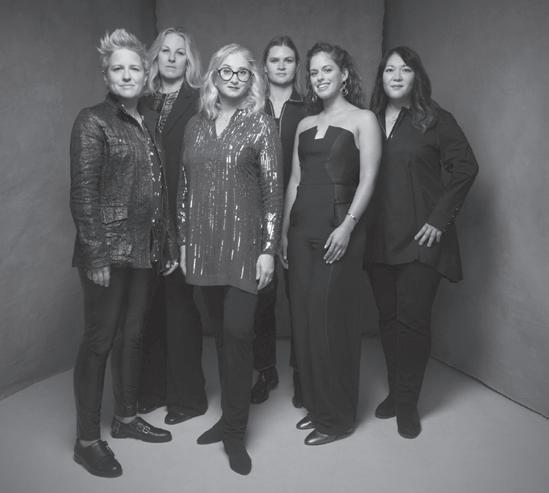
Rosnes was host of The Jazz Profiles, an interview series produced by CBC Radio, and has contributed two cover story interviews for JazzTimes with Wayne Shorter and with Geri Allen.
Rosnes is a member of bassist Ron Carter’s Foursight Quartet and often performs with her husband, acclaimed pianist Bill Charlap. The couple released Double Portrait and performed their New York City concert debut in Zankel Hall in spring 2011 as part of The Shape of Jazz series. The piano duo was also featured on Charlap and Tony Bennett’s 2016 Grammy-winning album, The Silver Lining: The Songs of Jerome Kern.
photo: Ebru YildizIngrid Jensen has been hailed as one of the most gifted trumpeters of her generation and is a sought-after teacher, collaborator and soloist.
After graduating from Berklee College of Music in 1989, Jensen became the youngest professor in the history of the Bruckner Conservatory in Linz, Austria. She recorded three albums for Enja Records in the 1990s and become one of the most in-demand trumpet players on the global jazz scene.
She has been a member of the innovative jazz orchestras of Maria Schneider (1994-2012) and Darcy James Argue (2002-present) and has performed with a cast of jazz legends ranging from Clark Terry to Esperanza Spalding. Jensen performed alongside British R&B artist Corinne Bailey Rae on Saturday Night Live and recorded with Canadian pop icon Sarah McLachlan. More recently, Jensen has been performing with Grammy-winner Terri Lyne Carrington.
One of Jensen’s most frequent and closest collaborators is her sister, the saxophonist and composer Christine Jensen. She is a featured soloist on the Christine Jensen Jazz Orchestra’s Juno Award-winning album Treelines (2011), and its successor, Habitat (2013). The sisters released a small group recording entitled Infinitude in 2016.
As a dedicated jazz educator, Jensen has taught at the University of Michigan and Peabody Conservatory; performed and lectured with the Thelonious Monk Institute High School group featuring Herbie Hancock; and performed and taught at the Centrum Jazz Workshop, The Dave Brubeck Institute, the Banff Centre Workshop in Jazz & Creative Music, the Stanford Jazz Camp, and the Geri Allen Jazz Camp for Young Women.
Jensen won the Carmine Caruso Trumpet Competition in 1995, recently served as artist-in-residence at the prestigious Monterey Jazz Festival and was hailed by the Jazz Journalist Association as 2019’s Trumpeter of the Year.
Her latest album, Invisible Sounds, honors the late Kenny Wheeler.
New York-based saxophonist Nicole Glover has been described as uninhibited, a rising saxophonist and a precocious talent. She first made her professional mark in her hometown of Portland, Oregon, recording
and performing with Grammy Award-winning artist Esperanza Spalding, acclaimed multi-instrumentalist George Colligan and renowned drummer/educator Alan Jones. Glover was a member of soul group Ural Thomas & The Pain, which received an Emmy Award for its feature episode of Oregon Art Beat. She also began performing internationally at festivals throughout Europe and North America and headlined the Portland Jazz Festival with her quartet. She has performed with such musicians as Kenny Garrett, Geoffrey Keezer, Bennie Maupin, Chuck Israels, Mike Clark, Bill Stewart, Mel Brown and Helen Sung.
Since Glover moved to New York City in 2015, she has recorded and toured with Gene Perla and has worked with Victor Lewis, Rodney Green, Jeff “Tain” Watts, David Weiss, Luis Perdomo, Jason Brown and Bill Goodwin. She has performed nationally and internationally at famed venues such as Birdland, Dizzy’s Club, Minton’s, Smalls, The Jazz Standard, Duc De Lombard, SFJAZZ, Jazz Bistro, Jazz Showcase, The Kennedy Center and numerous others. In 2019, Glover joined Grammynominated artist Buika for her world tour, which included performances at the Newport Jazz Festival, Red Sea Jazz Festival and Carnegie Hall. She released her latest album, Strange Lands, on Savant Records in August 2021.
Glover is also an experienced educator and clinician. She is currently on faculty with the New York Jazz Workshop and is a teacher for multiple charter schools through the Jazz Empowers program.
Alexa Tarantino is an award-winning jazz saxophonist, woodwind doubler, composer and educator. Her “highoctane [performance]” (JAZZIZ Magazine) and “sharply plotted but gracefully unencumbered straight-ahead jazz [compositions]” (The New York Times) establish her individual voice, which shines through as a dynamic performer and educator. Tarantino was recently named one of the Top 5 Alto Saxophonists of 2019 by the JazzTimes Critics Poll and nominated as a Rising Star – Alto Saxophone by DownBeat Magazine’s 2021 and 2020 Critics Poll.
She has appeared with a wide variety of ensembles including the Wynton Marsalis Septet, Jazz at Lincoln Center Orchestra, Cécile McLorin Salvant Quintet and Ogresse ensembles, Ulysses Owens Jr.’s Generation Y and Big Band, the Vanguard Jazz Orchestra, Arturo O’Farrill & the Afro Latin Jazz Orchestra and the DIVA
Jazz Orchestra, and leads the Alexa Tarantino Quartet. Firefly, Tarantino’s third record for Posi-Tone Records, was released in April 2021, hitting No. 6 on the JazzWeek charts.
Tarantino is on faculty for Jazz at Lincoln Center’s youth programs and represents the organization as a clinician and educator for various schools, festivals and workshops. She holds a master’s degree in jazz studies from The Juilliard School and bachelor’s degrees in jazz saxophone performance and music education from the Eastman School of Music.
Alexa Tarantino is a Vandoren Artist and Yamaha Performing Artist.
Noriko Ueda is originally from Hyogo, Japan. Her interest in music began early in her life, studying classical piano at the age of 4. At 16, she began playing the electric bass and by 18 she began her career with the upright bass.
Ueda was the B.E.S.T. scholarship recipient for the Berklee College of Music where she majored in Jazz Composition, graduating in 1997. She then relocated to New York City and has since become an in-demand player with such legendary groups such as the Frank Wess Quintet and his Nonet, the Ted Rosenthal Trio, Sherrie Maricle and the DIVA Jazz Orchestra, Five Play, Grady Tate’s band, Harry Whitaker’s band and with artists such as Marion Cowings, Makoto Ozone and Terumasa Hino.
Other career highlights to date include leading her own small groups and her big band, the Noriko Ueda Jazz Orchestra, and recording her first trio album, Debut (2015), which features pianist Ted Rosenthal and drummer Quincy Davis. She toured Japan with the Ted Rosenthal Trio for 11 consecutive years (2006-2017), and performed on his album Out of This World, which reached No. 1 on the national jazz radio charts in 2011.
Ueda was featured on a Japanese documentary show called Gutto Chikyu-bin, which introduced life as a jazz musician in New York City, and she won the third annual BMI Foundation/Charlie Parker Jazz Composition Prize for her original big band piece “Castle in the North.”
Drummer, composer and teacher Allison Miller has been described as a modern jazz icon in the making, has been named one of DownBeat’s Top 20 Jazz Drummers, and her composition “Otis Was a Polar Bear” is on NPR’s list of the 200 Greatest Songs by 21st Century Women. Miller served as a Monterey Jazz Festival 2019 artist in residence and is the first recipient of the Mid Atlantic Arts Foundation’s Commissioning Grant.
Miller’s band Boom Tic Boom, featuring pianist Myra Melford, violinist Jenny Scheinman, clarinetist Ben Goldberg, cornetist Kirk Knuffke and bassist Todd Sickafoose, recently celebrated its 10th anniversary with the release of their album Glitter Wolf. Previous releases include 5am Stroll, Boom Tic Boom, Live at Willisau, No Morphine No Lilies and Otis Was a Polar Bear.
Miller co-directs Parlour Game with Jenny Scheinman and Science Fair with Carmen Staaf. She is the musical director for Camille A. Brown’s ink, Michelle Dorrance and American Ballet Theatre’s Dream Within a Dream, Speak with Rachna Nivas and Michelle Dorrance, and And Still You Must Swing with Dormeshia Sumbry-Edwards.
As a side musician, Miller has collaborated with Ani DiFranco, Sara Bareilles, Natalie Merchant, Brandi Carlile and Toshi Reagon as well as Dr. Lonnie Smith, Patricia Barber, Marty Ehrlich, Myra Melford, Steven Bernstein and Ben Allison.
Miller is a three-time jazz ambassador for the U.S. State Department and has been appointed arts envoy to Thailand for her work with Jazz Education Abroad. She is on Yamaha’s Top 30 Clinicians List, teaches at the New School for Jazz and Contemporary Music in New York City and Stanford Jazz Workshop, and is the artistic director of Jazz Camp West. Her instructional videos are produced and published by Reverb. In 2008, Miller founded the Walter Salb Memorial Musical Scholarship Foundation in honor of her late teacher and mentor.
More information on ARTEMIS can be found at: Website: artemisband.com
Facebook: artemisjazzband
Instagram: @artemisjazz
Special Thanks:
Help secure dynamic programming in Santa Barbara by including Arts & Lectures in your estate plans. Your planned gift will enable us to educate, entertain and inspire for generations to come.
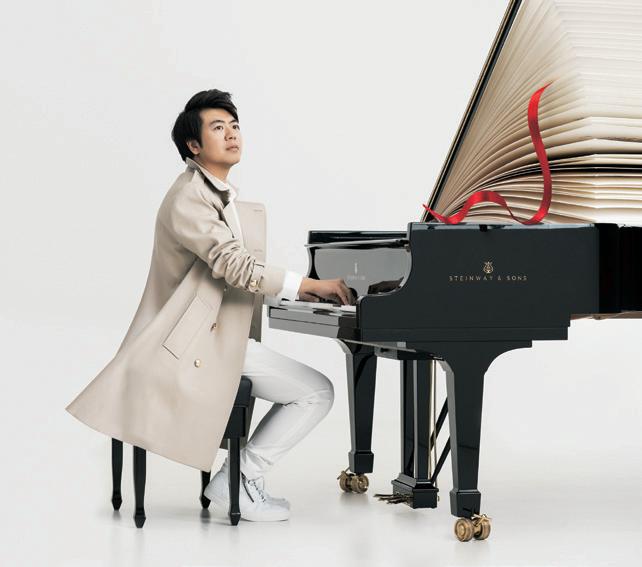
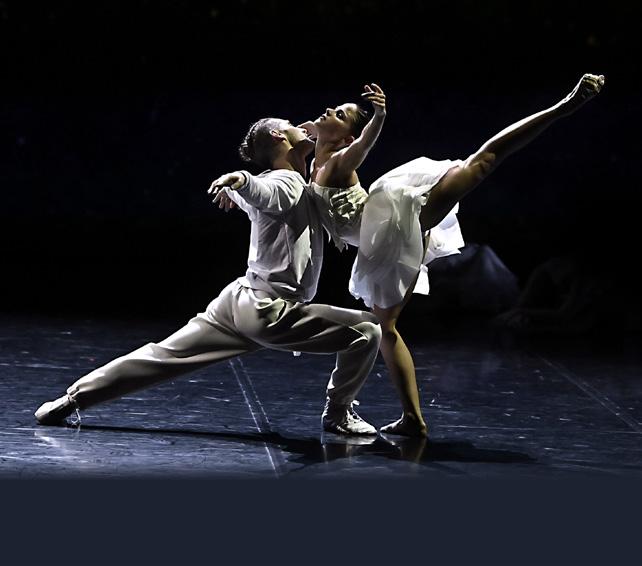
For more information about Legacy Giving contact Stacy Cullison at (805) 893-3755 or Stacy.Cullison@ArtsAndLectures.UCSB.edu
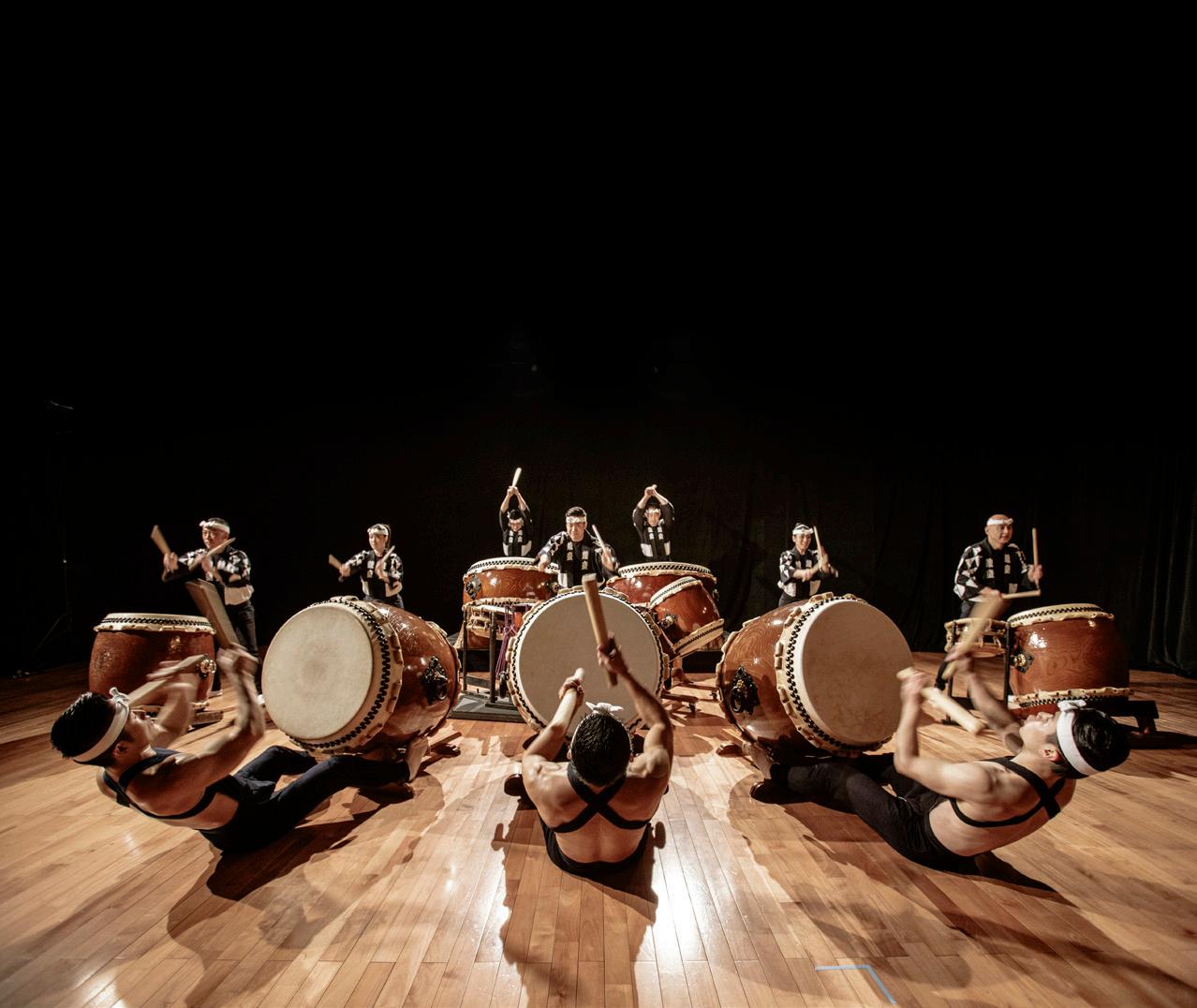
We do it with opportunities that are accessible to all. Through Access for ALL – Arts & Lectures’ Learning programs –inspirational, dynamic learning experiences are possible for students and lifelong learners across classrooms, our community and the UCSB campus.
Access for ALL serves more than 30,000 students and community members annually.
Here’s how we’re impacting our community:
• Assemblies in elementary and secondary schools
• Workshops and conversations with artists and speakers
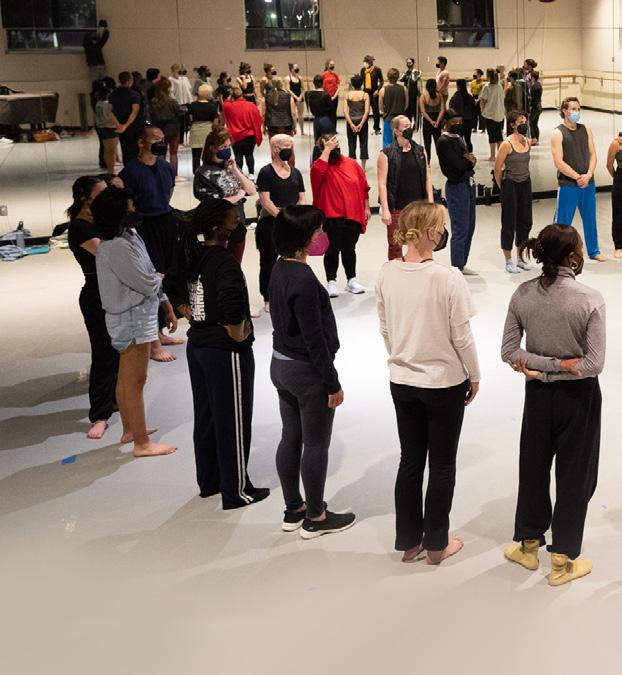
• Ticket subsidies for students at all levels
• The Thematic Learning Initiative’s lifelong learning opportunities
• Matinee field trips for K-12 students at The Granada Theatre
• Lecture-demonstrations and artist panels in University classes
• Master classes for students and community members
• Post-show Q&As with audiences of all ages
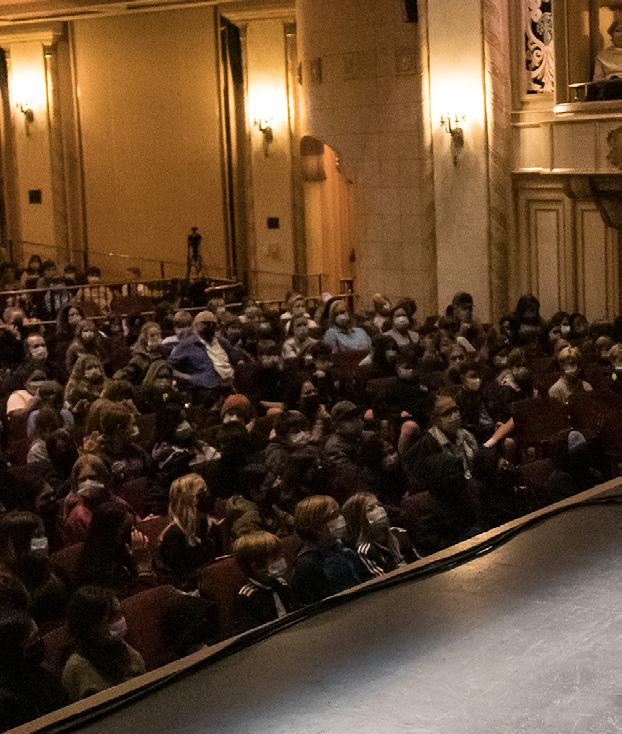
• Free family performances in under-resourced neighborhoods
Please consider a contribution to A&L’s award-winning educational outreach programs. Call Elise Erb at (805) 893-5679 to learn more.
photo: David Bazemore photo: Isaac Hernández photo: David BazemoreUCSB students and community members rehearse with dancers from Bill T. Jones/Arnie Zane Company before performing on the Granada stage
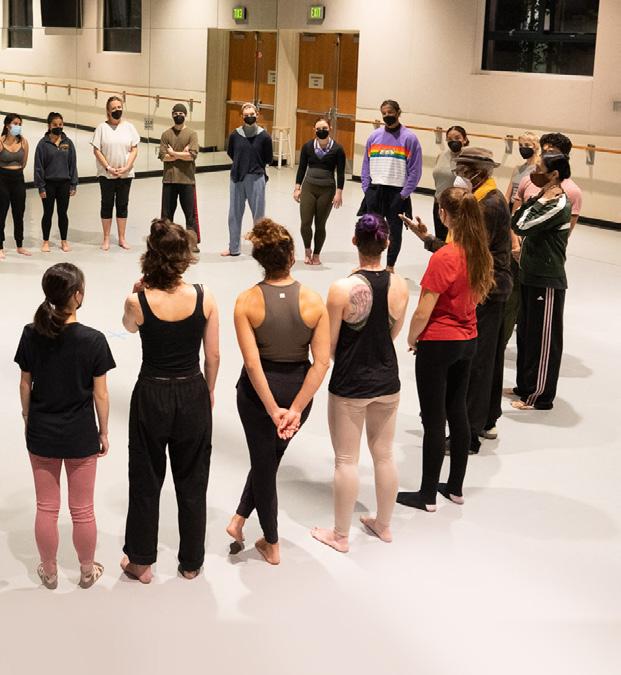
Thank you to our Education and ¡Viva el Arte de Santa Bárbara! Sponsors
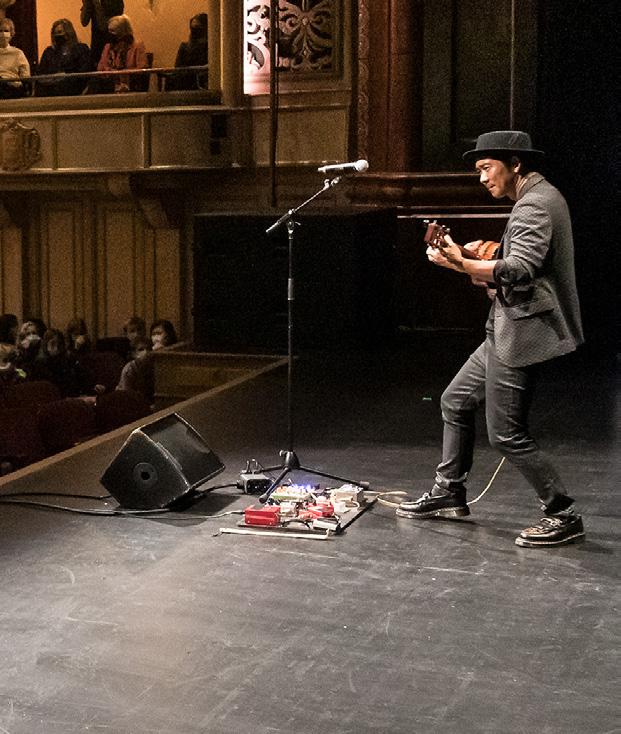
A&L
Sara Miller McCune
Audrey & Timothy O. Fisher
Connie Frank & Evan Thompson
UCSB Office of the Executive Vice Chancellor
UCSB Office of Education Partnerships
Kath Lavidge & Ed McKinley
Dorothy Largay & Wayne Rosing
Anonymous
Jake
Shimabukuro performs for more than 1,000 elementary school children at The Granada Theatre as part of A&L’s Arts Adventures bus-in program“If you want to find leverage to change the world, find a student.”
– Nicholas Kristof, Pulitzer Prize-winning journalist
¡Viva el Arte de Santa Bárbara! brings people together to share the rich cultural heritage of Latin America, serving more than 15,000 students and community members each year throughout Santa Barbara County.
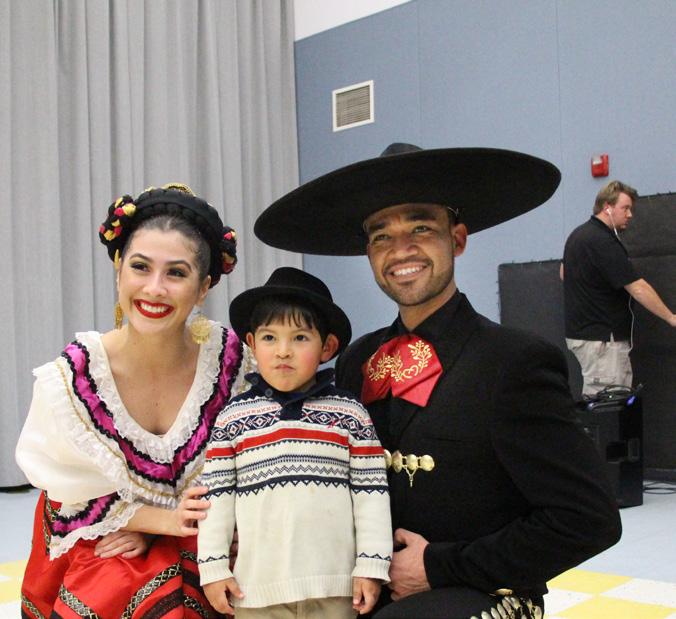

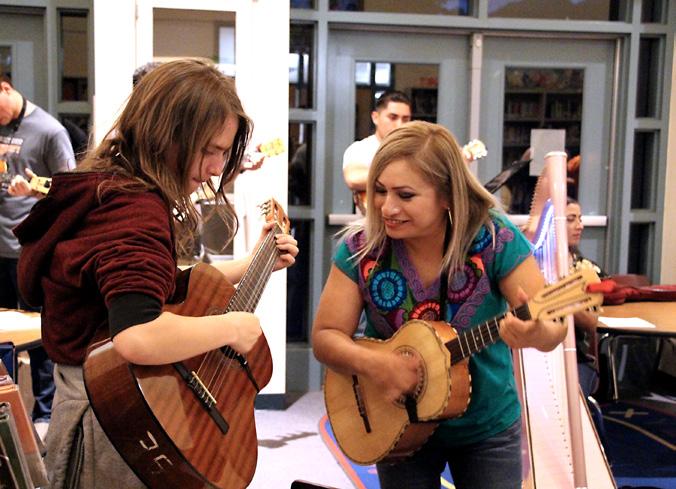
Viva builds bridges through live performance, shared experience and joyful, personal discovery. Created in 2006 out of a commitment to arts access for all, Viva works with dozens of local partners to present high-quality touring artists –Grammy winners and recognized cultural ambassadors – who share their knowledge, passion and commitment. Neighborhood spaces in schools, after-school programs and community centers come alive in these free programs for youth and families.
¡Viva el Arte de Santa Bárbara! is a collaboration between UCSB Arts & Lectures, The Marjorie Luke Theatre, the Guadalupe-Nipomo Dunes Center, and the Isla Vista School Parent Teacher Association serving Carpinteria, Santa Barbara, Goleta, Lompoc, Santa Maria, Guadalupe and New Cuyama.
• Tres Souls: April 14-16
• Las Cafeteras: May 19-21
Please consider a contribution to the awardwinning ¡Viva el Arte de Santa Bárbara! program. Call Director of Development Elise Erb at (805) 893-5679 to learn more.
A young audience member with Grandeza Mexicana dancers after a community performance Ballet Folklórico de Los Ángeles and Mariachi Garibaldi de Jaime Cuellar perform for families at Isla Vista School Mariachi Femenil Nuevo Tecalitlán teaching a community music workshop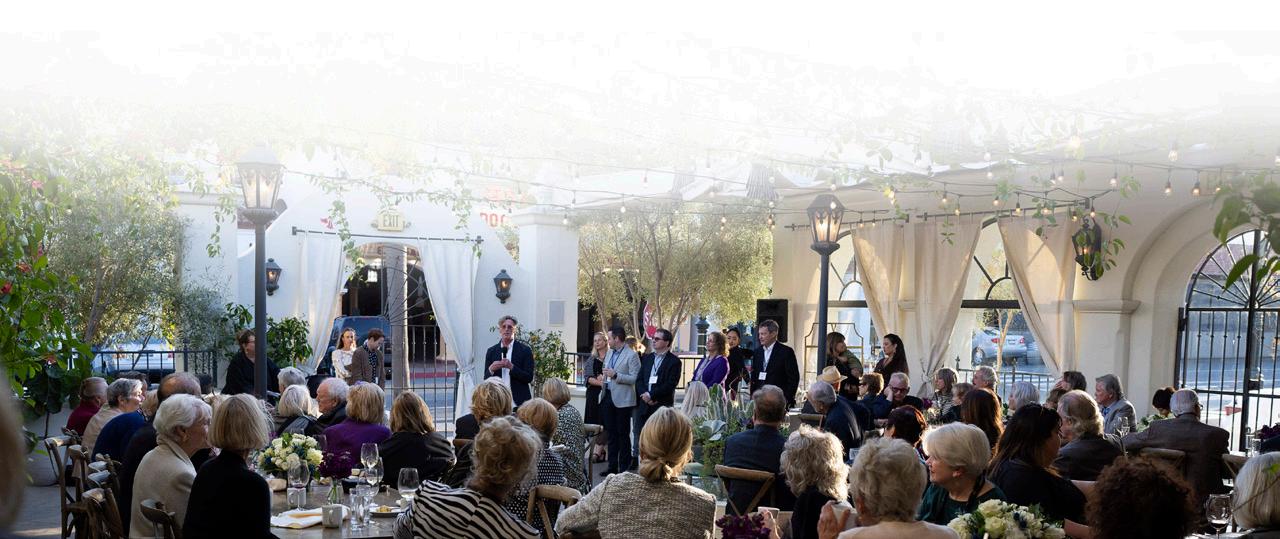
Be the force behind our community’s vibrant cultural life.
Arts & Lectures is privileged to acknowledge our Council, a group of insightful community leaders and visionaries who help us meet the challenge to educate, entertain and inspire.
Rich Janssen, Co-Chair
Kath Lavidge, Co-Chair
Marcy Carsey
Timothy O. Fisher
Dorothy Largay
Patricia MacFarlane
Susan McCaw
Sara Miller McCune
Jillian Muller
Natalie Orfalea
Tom Sturgess
Anne Smith Towbes
Lynda Weinman
Merryl Snow Zegar
Arts & Lectures is proud to acknowledge our Ambassadors, volunteers who help ensure the sustainability of our program by cultivating new supporters and assisting with fundraising activities.
Donna Fellows
Eva Haller
Robin Himovitz
Luci Janssen
Lois Mitchell
Maxine Prisyon
Bruce Heavin
Heather Sturgess
Anne Smith Towbes
Sherry Villanueva
Crystal Wyatt
Bridget Yin
Our Leadership Circle members, a group of key visionaries giving $10,000 to $100,000 or more each year, make a significant, tangible difference in the community and help bring A&L’s roster of premier artists and global thinkers to Santa Barbara. We are proud to recognize their philanthropy.
$100,000+
Jody & John Arnhold
Marcy Carsey
Audrey & Timothy O. Fisher ◊ ‡
Connie Frank & Evan Thompson
Eva & Yoel Haller ◊
William H. Kearns Foundation ‡
$50,000+
Marcia & John Mike Cohen ‡
Justin Brooks Fisher Foundation
$25,000+
Betsy Atwater
Mary Becker ‡
Cancer Foundation of Santa Barbara
Sarah & Roger Chrisman
Margo Cohen-Feinberg & Robert Feinberg
G.A. Fowler Family Foundation
Dorothy Largay & Wayne Rosing
Manitou Fund
Sara Miller McCune ◊ ‡
Jillian & Pete Muller
Natalie Orfalea & Lou Buglioli
Lynda Weinman & Bruce Heavin ◊ ‡
Martha Gabbert
Heather & Tom Sturgess ◊ ‡
Dick Wolf
Zegar Family Foundation
Anonymous
Bridget Yin & Russell Steiner Anonymous (2)
Luci & Rich Janssen ‡
Ellen & Peter O. Johnson
Siri & Bob Marshall
Earl Minnis
Montecito Bank & Trust
Laura & Kevin O’Connor
The Shanbrom Family Foundation
Barbara Stupay
Alison & Lyle Turner
Sheila Wald
Susan & Bruce Worster
$10,000+
Allyson & Todd Aldrich
Jennifer & Jonathan Blum
Tracy & Michael Bollag
The Otis Booth Foundation
Elizabeth & Andrew Butcher
Casa Dorinda Retirement Residence
Scott Charney & Ellen McDermott Charney
Tana & Joe Christie
NancyBell Coe & William Burke ‡
David & Debby Cohn
Thiep Cung AIA
Bettina & Glenn Duval
Donna M. Fellows
Robyn & Larry Gottesdiener
Lisa & Mitchell Green
Robin & Roger Himovitz
Tom Kenny
Marilyn & Dick Mazess
Stacy & Ron Pulice
Sharon & Bill Rich
Merrill Sherman
Linda Stafford Burrows
The Stone Family Foundation
Pam & Russ Strobel
Diane Sullivan
Anne Smith Towbes ‡
MUFG Union Bank, N.A.
Nicole & Kirt Woodhouse
Crystal & Clifford Wyatt
Anonymous
Arts & Lectures gratefully recognizes the commitment and generosity of our Producers Circle members, who have made gifts between $2,500 and $9,999. Recognition is based upon cumulative giving within a 12-month period.
$5,000+ Executive Producers Circle
Leslie Sweem Bhutani
Tim Buckley
Meg & Dan Burnham
Annette & Dr. Richard Caleel
Laura Clifford
Susan Eng-Denbaars & Steve Denbaars
Olivia Erschen & Steve Starkey
Priscilla & Jason* Gaines
Pamela Gann & David Hardee
Jeff & Nanette Giordano
Tricia & Don Green
Anna & Nathan Alldredge
Roxana & Fred Anson
Deirdre & William Arntz
Martha & Bruce Atwater
Marta Babson
Jill & Arnie Bellowe
Deirdre & Fraser Black
Susan D. Bowey
Michael Brinkenhoff
- In Memory of Gayle Tower Brinkenhoff
Victoria Hendler Broom
Wendel Bruss
Sherri Bryan & Tim Dewar
Susan & Claude Case
Lilyan Cuttler & Ned Seder
Deborah David & Norman A. Kurland
Deanna & Jim Dehlsen
Phyllis de Picciotto & Stan Roden
Eva Ein & Michael Palmer
Julia Emerson
Doris & Tom Everhart
Bunny Freidus
Tisha Ford
Patricia & Michael French
Grafskoy Hindeloopen Limited, LLC
Paul Guido & Stephen Blain
Ruth & Alan Heeger
Shauna & Robert Hirsch
Daniel & Mandy Hochman
The Ann Jackson Family Foundation
Maia Kikerpill & Daniel Nash
Chris & Mark Levine
Cindy & Steve Lyons
Nancy McGrath
Ann & John McReynolds
Suzanne & Duncan Mellichamp
Lisa Reich & Bob Johnson
Julie Ringler & Richard Powell
Kyra & Tony Rogers
Ginger Salazar & Brett Matthews
Laurie Siegel & Joseph Nosofsky
Maurice & Hyon Singer
Joan Speirs
The Towbes Foundation
Sandra & Sam Tyler
Judy Wainwright Mitchell & Jim Mitchell
Dr. Richard Watts
Dr. Bob Weinman
Laura & Geofrey Wyatt
Anonymous (2)
Donna & Daniel Hone
Judith L. Hopkinson ‡
Shari & George Isaac
Carolyn Jabs & David Zamichow
Annie & Andrew Kaiser
Mary Grace Kaljian
Margaret & Barry Kemp
Connie & Richard Kennelly
Linda & Bill Kitchen ‡
Jill & Barry* Kitnick
Nancy & Linos Kogevinas
Barbara Shattuck Kohn & Gene Kohn
Larry Koppelman
Patricia Lambert & Frederick Dahlquist
Jacqueline & Robert Laskoff
Karen Lehrer & Steve Sherwin
Mark Levy
Denise & George Lilly
Peggy Lubchenco & Steve Gaines
Nancy & Mike McConnell
Amanda McIntyre
Gene l. Miller
Michael Millhollan & Linda Hedgepeth
Lois & Mark Mitchell
Harriet Mosson
Elizabeth & Charles Newman
Dale & Michael Nissenson
Jan Oetinger
Cheri Owen & Jenni Sorkin
Lynn & Mel* Pearl
Ann & Dante Pieramici
Ann Pless
Justine Roddick & Tina Schlieske
Charlie & Dr. Herb Rogove
Susan J. Rose
Gayle & Charles Rosenberg
Dr. William E. Sanson
Jo & Ken Saxon
Maryan Schall
Anitra Sheen
Lynne Sprecher
Carol Spungen
Dale & Gregory Stamos
Kirstie Steiner & John Groccia
Debra & Stephen Stewart
Mary Jo Swalley ◊
Denise & James Taylor
Amy & George Tharakan
David Tufts & Cris Dovich
Alan & Kathryn Van Vilet
Dianne & Daniel Vapnek
Sherry & Jim Villanueva
Vicki & Franz von Holzhausen
Esther & Tom* Wachtell
Alexis & Michael Weaver
Kathy Weber
$1,000+
Holly Becker
Jill Bradnin
Drs. Paula & Thomas Bruice
Michele Brustin
David Cadoff
Marian & Rabbi Stephen Cohen
Ann Daniel
$500+
Bernadette Bagley
Peggy & Steve Barnes
Linda & Peter Beuret
Rochelle & Mark Bookspan
G. Donald Chandler III
$250+
Catherine L Albanese
Michael & Marilyn Avenali
Carolyn Chandler
Victoria Dillon
$100+
Dorothy & Peter Abbey
Rene Aiu
Julia Alcerro
Lynn & Joel Altschul
Virginia Anders
Katya Armistead
Mickey Babcock
Kelly Bartlett
Randy Bassett
Thomas Bedland & Laurel Luby
Wayne Benner
Randall Berg
Norrine Besser
Tracy J. Blakeslee
Carol Brown
Todd Canfield
Michael Chabinyc
Ramona & Guy Clark
Norm Cohen
Maurice J. Cooper
Doreen Daley Skopp
Deva Dalporto
Lila Deeds
Lynn Daniels & John Matthews
Timothy A. Eaton
Vasanti & Joel Fithian
Cid & Thomas* Frank
Andrea & Mark Gabbay
Dave Johnson
Robert & Janet Kates
Rebecca & Chuck Kaye
Danson Kiplagat
Roger & Barbara Kohn
Susan Matsumoto & Mel Kennedy
Nancy & Douglas Norberg
Joan Pascal & Ted Rhodes
Robin Rickershauser
Diane & Charles Sheldon
Delia Smith
- In Memory of Paul A. Smith
Nati & Michael Smith
Trudy Smith & Doyle Hayes
Beth & Dodd Geiger
Kris & Eric Green
Sandra Howard
Elinor & James Langer
Maureen Latourrette
Janice Toyo & David Levasheff
Cathy & Bruce Milner
Almeda & J. Roger Morrison
Carol & Stephen Newman
Minie & Hjalmer
Pompe van Meerdervoort
Andrew Primack
Bhupi Singh & Gurinder Kaur
Claire & Glenn VanBlaricum
Carol Vernon
Elizabeth Downing & Peter Hasler
James & Diane Giles
Nancy Guthrie
Stacey & Raymond Janik
Pamela Lombardo
Jeanne & Larry Murdock
Kathlyn & William Paxton
Peter Rathbone
Mark & Kathy Rick
Anita & Eric Sonquist
Anne & Tony Thacher
Carol Wharmby
Anonymous
Edward & William* DeLoreto
Joan & Thomas Dent
Arlene & Marty Donohue
Tina Downs
James Du
Kay Egan
Donnelley & Cinda Erdman
Lorne Fienberg
Arthur Flynn
Marsha Fonteyn
Carole & Ron Fox
Joe Franken
Michelle Gaitan
Andrew Gerson
Steve Ginder
Lin Goodnick
Diane Graham
Hildegard Gray
Gayle Hackamack
Laura & Michael Hamman
Harla Hampton
Janet Healy
Lauren Hobratsch
Richard Hogue
Kathryn Hughes
Katherine Hunter
Laura Ishikawa & Benjamin Weiman
Susan Kadner
Lois Kaplan
Jean Keely
Anna & Peter Kokotovic
Karina Kulangara
Daniel Lewin
Sheila Lodge
Martin Lynch
Cheri & Christopher Mersey
Kindred Murillo
Dennis & Carolyn Naiman
Kathleen Nienhouse
Marilyn & Jack Perry
Fredric Pierce
Deborah & Ken Pontifex
Caroline Powers
Susan Renefrew
Adele Rosen
Carol Sacks
Susan Sanborn
Joan & Steven Siegel
Ellen & Harvey Silverberg
Mitchell Sjerven
Terry & Art Sturz
Linda Swartz
Sharon Terry
Sharron Thomas
William & Diana Thomas
Susan Thomason
John Turnham
Frederick & Marion Twichell
Katherine Van Meter
Lorraine Vanmeter-Cline
Arturo Vega & Rebecca Hardin
David Warnock
John Warnock
Elizabeth Watson
Jo Ellen & Thomas Watson
Karl Weis
William Wellman
Anonymous
Legacy Circle members listed below have made provisions in their estate plans to support A&L and ensure our exciting programs continue for future generations. We are pleased to acknowledge these thoughtful commitments.
Judy & Bruce Anticouni
Helen Borges*
William B. Cornfield*
Ralph H. Fertig*
Audrey & Timothy O. Fisher
Georgia Funsten*
Eva & Yoel Haller
Susan Matsumoto & Mel Kennedy
Sara Miller McCune
Lisa A. Reich
Sharon & Bill Rich
Hester Schoen*
Heather & Tom Sturgess
Lynda Weinman & Bruce Heavin
Fund for Programmatic Excellence
Beth Chamberlin Endowment for Cultural Understanding
Commission of New Work Fund
Education and Outreach Fund
Sara Miller McCune Executive Director of Arts & Lectures
Harold & Hester Schoen Arts & Lectures Endowment
Sonquist Family Endowment
Lynda Weinman & Bruce Heavin Arts & Lectures Endowment for Programmatic Excellence
California Arts Council
City of Santa Barbara
National Dance Project
National Endowment for the Arts
Santa Barbara County Office of Arts & Culture
UCSB Summer Culture and Community Grant Program
Arts & Lectures is especially grateful to UCSB students for their support through registration and activity fees. These funds directly support lower student ticket prices and education sessions with A&L artists and speakers who visit classes.
Celesta M. Billeci, Miller McCune Executive Director
Meghan Bush, Associate Director
Ashley Aquino, Contracts Administrator
Marisa Balter, Financial Analyst
Michele Bynum, Senior Artist
Stacy Cullison, Senior Director of Development & Special Initiatives
Carmela Marie Distura, Assistant Ticket Office Manager
Charles Donelan, Senior Writer/Publicist
Matthew Elkins, Chief Financial & Operations Officer
Elise Erb, Director of Development
Macie Ericksen, Production Coordinator
Kevin Grant, Senior Business Analyst
Ashley Greene, Education Programs Coordinator
Nina Johnson, Campus & Community Engagement & Special Projects Manager
Rachel Leslie, Membership Director
Mari Levasheff, Marketing Manager
Hector Medina, Marketing & Communications Production Specialist
Caitlin O’Hara, Director of Public Lectures & Special Initiatives
Elizabeth Owen, Programming Manager
James Reisner, Manager of Ticketing Operations
Julianna Swilley, Arnhold Education Associate
Angelina Toporov, Marketing Specialist
Laura Wallace, Finance & HR Manager
Eliot Winder, Production Manager
List current as of March 21, 2023. Every effort has been made to ensure accuracy. Please notify our office of any errors or omissions at (805) 893-3382.
*In Memoriam
◊ Indicates those who have made plans to support UCSB Arts & Lectures through their estate ‡ Indicates those who have made gifts to Arts & Lectures endowed funds in addition to their annual program support
Tue, Apr 25 / 7:30 PM / Campbell Hall
Ada Limón was born in Sonoma, California in 1976 and is of Mexican ancestry. She is the author of six poetry collections including The Carrying (2018), which won the National Book Critics Circle Award for Poetry; Bright Dead Things (2015), a finalist for the National Book Award, the National Books Critics Circle Award and the Kingsley Tufts Poetry Award; Sharks in the Rivers (2010); Lucky Wreck (2006) and This Big Fake World (2006).
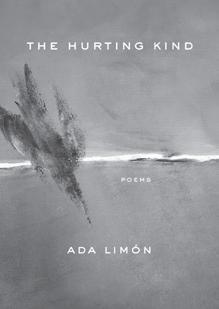
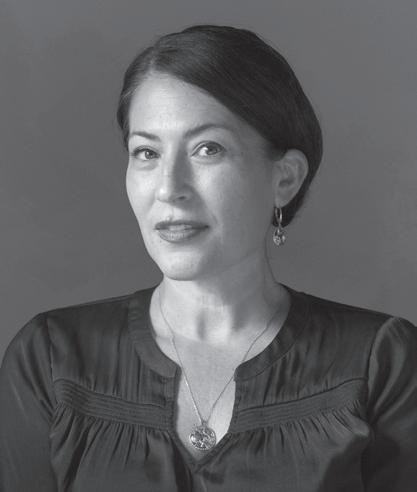
Her work has been supported most recently by a Guggenheim Fellowship. She was the host of the critically-acclaimed poetry podcast The Slowdown. She now lives in Lexington, Kentucky where she writes and teaches remotely. Her new book of poetry, The Hurting Kind, is out now from Milkweed Editions. She is the 24th poet laureate of the United States.
Limón earned a Master of Fine Arts degree from New York University and is the recipient of fellowships from the Guggenheim Foundation, the New York Foundation for the Arts, the Provincetown Fine Arts Work Center and the Kentucky Foundation for Women.
Books are available for purchase in the lobby and a signing follows the event
Celebrating National Poetry Month! Presented in association with UCSB College of Creative StudiesIsabella Rossellini grew up in Paris and Rome. She made her acting debut in 1979 in the Taviani brothers’ film Il Prato (The Meadow) and has appeared in numerous other films including Blue Velvet, Wild at Heart, White Nights, Rodger Dodger, Cousins, Death Becomes Her, Fearless, Big Night and Joy. She has worked with directors including Robert Zemeckis, David O. Russell, David Lynch, Robert Wilson, Taylor Hackford, Marjane Satrapi and Guy Maddin.
She is also a successful television actress and filmmaker, with a keen interest in animals and wildlife conservation. She has a master’s degree in Animal Behavior and Conservation and has received an honorary doctorate from the Science Faculty at UQAM (University of Quebec at Montreal). Her award-winning series of shorts Green Porno, Seduce Me and Mammas offer comical and scientifically insightful studies of animal behavior.
Rossellini has been seen in Vita and Virginia, The Incredibles and Silent Retreat. Her television work includes Master of Photography, Domina and Shut Eye. Her book My Chickens and I was published in several languages by Abrams Books.
Rossellini’s interests embrace preservation of her family’s extraordinary cinematic heritage, including the films directed by her father, Roberto Rossellini, and those featuring her mother, Ingrid Bergman. She is a mother of two and resides in Bellport, Long Island. She runs an organic farm in Brookhaven in association with the Peconic Land Trust.
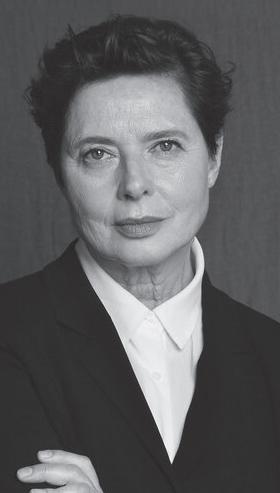
Thu, Apr 27 / 7:30 PM / The New Vic (note new venue)
Speaking with Pico Series Sponsors: Martha Gabbert, Siri & Bob Marshall, and Laura & Kevin O’Connor
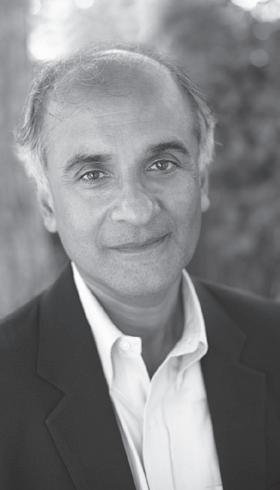
Pico Iyer is the author of 16 books, translated into 23 languages, and dealing with subjects ranging from the XIVth Dalai Lama to Islamic mysticism and from globalism to the Cuban Revolution. They include such long-running sellers as Video Night in Kathmandu, The Lady and the Monk, The Global Soul and The Art of Stillness. He has also written the introductions to more than 70 other books, the liner notes for many Leonard Cohen albums and Criterion Collection movies and a screenplay for Miramax. Since 1986 he has been a regular essayist for Time, The New York Times, Harper’s, The New York Review of Books and many others.
His four TED talks have received more than 11 million views, and he has been featured in program-length interviews with Oprah, Krista Tippett and Larry King, among others.
Born in Oxford, England in 1957, he was a King’s Scholar at Eton and was awarded a Congratulatory Double First at Oxford, where he received the highest marks of any student on English Literature at the university. He received a second master’s degree at Harvard and was recently a Ferris Professor at Princeton.
Based since 1987 in Japan, he travels widely, and his latest book, The Half Known Life, describes experiences in Iran, North Korea, Kashmir, Sri Lanka, Jerusalem and Australia.
Special Thanks:
Laura Dern and Diane Ladd always had a close relationship, but the stakes were raised when Diane developed a sudden, life-threatening illness. Ladd’s doctor prescribed long walks to build back her lung capacity. The exertion was challenging, and Dern soon learned the best way to distract her mom was to get her talking and telling stories.
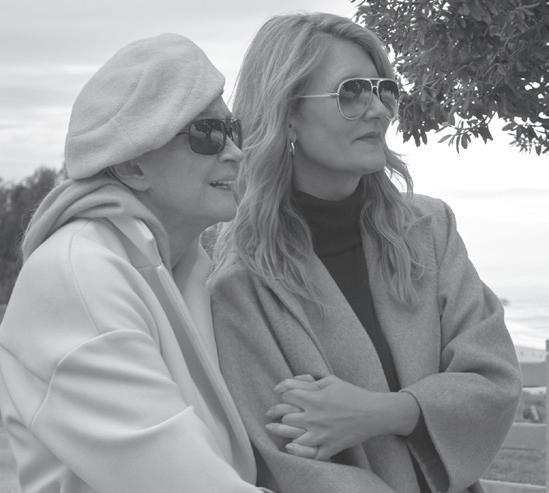
Their conversations along the way began to break down the traditional barriers between mothers and daughters. They discussed the most personal topics: love, sex, marriage, divorce, art, ambition and legacy. In their new book Honey, Baby, Mine , Dern and Ladd share these conversations, as well as reflections and anecdotes, taking readers on an intimate tour of their lives.
Wed, May 3 / 7:30 PM / Campbell Hall
Laura Dern is an award-winning actor, producer, creator and activist. She has received a number of accolades, including an Academy Award, an Emmy and five Golden Globe Awards. Dern is also a passionate environmentalist.
Diane Ladd is an international award-winning actress, receiving a British Academy of Film and Television Arts (BAFTA) Award and a Golden Globe Award. She is a three-time Oscar and three-time Emmy nominee, having appeared in more than 187 film and television shows. She is a director, writer, producer and author with degrees in esoteric psychology/nutrition, a lifetime member of the Actors Studio, and is on the National Board of Directors for SAG-AFTRA (Screen Actors Guild and the American Federation of Television and Radio Artists).
Special Thanks:
Music by Burt Bacharach
Lyrics by Hal David
Lyrics from “The Blob” by Mack David
Arranged by Ethan Iverson
Choreography by Mark Morris
Costume and Production Design by Isaac Mizrahi
Lighting Design by Nicole Pearce
Costume Associate, Marla Wonboy
Alfie
What the World Needs Now
I’ll Never Fall in Love Again
Message to Michael
Raindrops Keep Falling on My Head
Do You Know the Way to San Jose
Anyone Who Had a Heart
Walk on By
Don’t Make Me Over
Are You There (With Another Girl)
The Blob
Always Something There to Remind Me
The Look of Love
I Say a Little Prayer
Used by permission. All rights reserved.
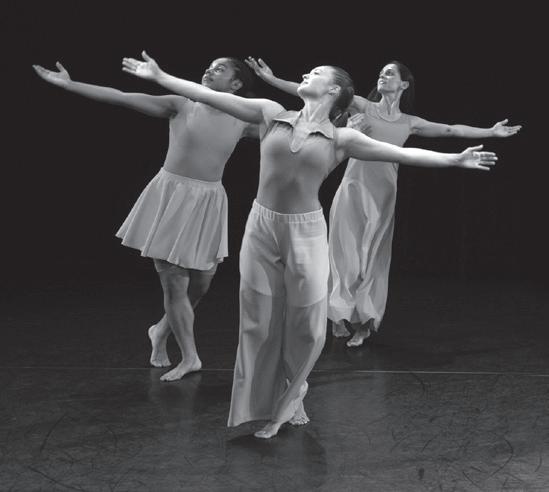
Mark Morris, Choreographer and Artistic Director
Sat, May 6 / 8 PM / Granada Theatre
Running time: approx. 60 minutes, no intermission Please stay after the performance for a Q&A with the artists.
Event Sponsor: G.A. Fowler Family Foundation
Dance Series Sponsors:
Margo Cohen-Feinberg & Bob Feinberg, Ellen & Peter O. Johnson, Barbara Stupay, and Sheila Wald
Made possible by gifts to the A&L Commission of New Work Endowment Fund
Presented in association with UCSB Department of Theater and Dance
Mica Bernas*, Karlie Budge*, Brandon Cournay, Domingo Estrada, Jr.*, Courtney Lopes* ,
Taína Lyons*, Matthew McLaughlin, Dallas McMurray*, Brandon Randolph* , Nicole Sabella*, Christina Sahaida, Billy Smith*, Noah Vinson*, Malik Q. Williams
* Performing on 5/6
Marcy Harriell, lead vocals
Ethan Iverson, piano
Brandon Choi, trumpet
Simón Willson, bass
Vinnie Sperrazza, drums
Clinton Curtis, background vocals
Blaire Reinhard, background vocals
The Mark Morris Dance Group (MMDG) was formed in 1980 and gave its first performance that year in New York City. The company’s touring schedule steadily expanded to include cities in the United States and around the world, and in 1986 it made its first national television program for the PBS series Dance in America. In 1988, MMDG was invited to become the national dance company of Belgium and spent three years in residence at the Théâtre Royal de la Monnaie in Brussels. The Dance Group returned to the U.S. in 1991 as one of the world’s leading dance companies. Based in Brooklyn, New York, MMDG maintains strong ties to presenters in several cities around the world, most notably to its West Coast home, Cal Performances in Berkeley, California, and its Midwest home, the Krannert Center for the Performing Arts at the University of Illinois at UrbanaChampaign. MMDG also appears regularly in New York, Boston, Seattle, and Fairfax. In New York, the company has performed at New York City Center’s Fall for Dance Festival, regularly performs at Lincoln Center for the Performing Arts’ Mostly Mozart and White Light festivals, and collaborates yearly with BAM on performances and master classes. From the company’s many London seasons, it has received two Laurence Olivier Awards and a Critics’ Circle Dance Award for Best Foreign Dance Company. Reflecting Morris’ commitment to live music, the Dance Group has featured live musicians in every performance since the formation of the MMDG Music Ensemble in 1996. MMDG regularly collaborates with renowned musicians including cellist Yo-Yo Ma, pianist Emanuel Ax, mezzo-soprano Stephanie Blythe and jazz trio The Bad Plus, as well as leading orchestras and opera companies including the Metropolitan Opera, English National Opera and the London Symphony Orchestra. MMDG frequently works with distinguished artists and designers, including painters Robert Bordo and the late Howard Hodgkin, set designers Adrianne Lobel and Allen Moyer, costume designers Martin Pakledinaz and Isaac Mizrahi and many others. MMDG’s film and television projects include Dido and Aeneas, The Hard Nut, Falling Down Stairs, two documentaries for the U.K.’s South Bank Show, and PBS’ Live From Lincoln Center. In 2015, Morris’ signature work L’Allegro, il Penseroso ed il Moderato had its national television premiere on PBS’ Great Performances While on tour the Dance Group partners with local cultural institutions and community organizations to present arts and humanities-based activities for people of all ages and abilities.
The MMDG Music Ensemble, formed in 1996, is integral to the Dance Group. “With the dancers come the musicians… and what a difference it makes” (Classical Voice of North Carolina). The Ensemble’s repertory ranges from 17th and 18th century works by John Wilson and Henry Purcell to more recent scores by Ethan Iverson, Lou Harrison and Henry Cowell. The musicians also participate in the Dance Group’s educational and community programming at home and on tour. The Music Ensemble is led by Colin Fowler, who began to collaborate with MMDG in 2005 during the creation of Mozart Dances.
Mark Morris was born on August 29, 1956, in Seattle, Washington, where he studied with Verla Flowers and Perry Brunson. In the early years of his career, he performed with the companies of Lar Lubovitch, Hannah Kahn, Laura Dean, Eliot Feld and the Koleda Balkan Dance Ensemble. He formed the Mark Morris Dance Group in 1980 and has since created over 150 works for the company. From 1988 to 1991, he was director of dance at Brussels’ Théâtre Royal de la Monnaie, the national opera house of Belgium. In 1990, he founded the White Oak Dance Project with Mikhail Baryshnikov. Much in demand as a ballet choreographer, Morris has created 22 ballets since 1986 and his work has been performed by companies worldwide, including San Francisco Ballet, American Ballet Theatre, Ballet am Rhein, Dusseldorf and the Royal New Zealand Ballet. Noted for his musicality, Morris has been described as “undeviating in his devotion to music” (The New Yorker). He began conducting performances for MMDG in 2006 and has since conducted at Tanglewood Music Center, Lincoln Center and BAM (Brooklyn Academy of Music). He served as music director for the 2013 Ojai Music Festival. He also works extensively in opera, directing and choreographing productions for the Metropolitan Opera, New York City Opera, English National Opera and The Royal Opera, Covent Garden, among others. He was named a fellow of the MacArthur Foundation in 1991 and has received eleven honorary doctorates to date. He has taught at the University of Washington, Princeton University and Tanglewood Music Center. He is a member of the American Academy of Arts and Sciences and the American Philosophical Society, and has served as an advisory board member for the Rolex Mentor and Protégé Arts Initiative. Morris has received the Samuel H. Scripps/American Dance Festival Award for Lifetime Achievement, the Leonard Bernstein
Lifetime Achievement Award for the Elevation of Music in Society, the Benjamin Franklin Laureate Prize for Creativity, the International Society for the Performing Arts’ Distinguished Artist Award, Cal Performances Award of Distinction in the Performing Arts, the Orchestra of St. Luke’s Gift of Music Award and the 2016 Doris Duke Artist Award. In 2015, Morris was inducted into the Mr. and Mrs. Cornelius Vanderbilt Whitney Hall of Fame at the National Museum of Dance in Saratoga Springs, New York. Morris opened the Mark Morris Dance Center in Brooklyn, New York, in 2001 to provide a home for his company, subsidized rental space for local artists, community education programs for children and seniors and a school offering dance classes to students of all ages and levels of experience with and without disabilities. Morris’ memoir, Out Loud, co-written with Wesley Stace, was published in paperback by Penguin Press in October 2021.
Burt Bacharach (1928-2023) was one of the world’s most acclaimed, award-winning composer/songwriters. His music is as diverse as his audiences, spanning generations and continents, as he is celebrated both as a pop culture icon and one of the greatest contemporary composers. Bacharach’s credits read like the world’s favorite radio stations’ playlist: “Alfie,” “Arthur’s Theme,” “Close to You,” “Do You Know the Way to San Jose,” “I Say a Little Prayer,” “I’ll Never Fall in Love Again,” “This Guy’s in Love With You,” “Walk On By,” “What the World Needs Now Is Love” and “Wishin’ And Hopin’” are among just the 48 top-10 hits and nine No. 1 songs. Bacharach and Hal David were the recipients of the 2012 Library of Congress Gershwin Prize for Popular Song. The prize is awarded to musicians whose lifetime contributions in the field of popular song exemplify the standard of excellence associated with the Gershwins. Bacharach and David received the Library’s Gershwin Medal in May 2012 at an all-star tribute in Washington, D.C. Bacharach’s memoir, Anyone Who Had a Heart, which is named after one of many songs Bacharach and David wrote for Dionne Warwick, was released in May 2013. Bacharach composed his first film score in 16 years for John Asher’s autism-based drama A Boy Called Po, released in April 2016. Bacharach and Daniel Tashian released two new songs called “Moon Over Wichita” and “Heartbreak Storms” via Big Yellow Dog Music in April 2022. The songs are a continuation of their Grammynominated Blue Umbrella EP, released in 2020, and Blue Umbrella (The Complete Recordings), which was released in 2021 and featured four never-before-heard songs.
Bacharach and Steven Sater’s Some Lovers, featuring vocal performances from some of Broadway’s most beloved co-stars, was released in November 2021. The album was nominated for a Grammy Award for Best Musical Theater Album.
Hal David (1921-2012) is known for his award-winning lyrics that have been featured in films, Broadway shows and music charts throughout his career. Being honored through numerous Grammys, the National Association of Recording Merchandisers Presidential Award and more, he is best known for his collaborations with composer Burt Bacharach, whom he met in 1957. The two wrote their first hit, “The Story of My Life,” and then continued to write iconic American pop songs throughout the 1960s and ’70s. In 2012, David and Bacharach received the Gershwin Prize for Popular Song. But the duo was not just known for the pop songs they created. They also wrote for movies, with four of their songs being nominated for Academy Awards: “What’s New, Pussycat?,” “Alfie,” “The Look of Love” and “Raindrops Keep Falling on My Head.” “Raindrops Keep Falling on My Head” also won an Oscar in 1970. Lincoln College bestowed a Doctor of Music degree on David for his contribution to American music. In October of 2007, David received an honorary degree from the Five Towns College in Long Island and, in addition, they named their new music library building The Hal David Music Library. David is a member of the Nashville Songwriters Hall of Fame and was the first nonBritish person to receive the Ivor Novello Award from the British Performing Rights Society.
Ethan Iverson
Pianist, composer and writer Ethan Iverson first came to international prominence as a founding member of The Bad Plus (TBP), a game-changing collective with Reid Anderson and David King. The New York Times called TBP “better than anyone at melding the sensibilities of post-’60s jazz and indie rock.” During his 17-year tenure, TBP performed in venues as diverse as the Village Vanguard, Carnegie Hall and Bonnaroo; collaborated with Joshua Redman, Bill Frisell and the Mark Morris Dance Group and created a faithful arrangement of Igor Stravinsky’s The Rite of Spring and a radical reinvention of Ornette Coleman’s Science Fiction. Since leaving TBP, Iverson has kept busy. In 2017, he co-curated a major centennial celebration of Thelonious Monk at Duke University and premiered the evening-length Pepperland with the Mark Morris Dance Group. In 2018, he premiered an original piano concerto with the
American Composers Orchestra and released a duo album of new compositions with Mark Turner on ECM. In 2019, he released Common Practice with Tom Harrell on ECM, standards tracked live at the Village Vanguard. In 2021, he released the big-band work Bud Powell in the 21st Century and was featured on the March cover of DownBeat. In 2022, he released Every Note Is True on Blue Note records, an album of original music with Larry Grenadier and Jack DeJohnette. Iverson has also been in the critically-acclaimed Billy Hart Quartet for well over a decade and occasionally performs with elder statesmen like Albert “Tootie” Heath and Ron Carter or collaborates with noted classical musicians like Miranda Cuckson and Mark Padmore. For almost 20 years, Iverson’s website Do the M@th has been a repository of musician-to-musician interviews and analysis. Time Out New York selected Iverson as one of 25 essential New York jazz icons: “Perhaps NYC’s most thoughtful and passionate student of jazz tradition –the most admirable sort of artist-scholar.” Iverson has also published articles about music in The New Yorker, NPR, The Nation and JazzTimes.
Isaac Mizrahi has worked extensively in the entertainment industry as a performer, host, writer, designer and producer for more than 30 years. He has an annual residency at Café Carlyle in New York City and has performed at various venues across the country such as Joe’s Pub, The Regency Ballroom and several City Winery locations nationwide. The New York Times noted, “he qualifies as a founding father of a genre that fuses performance art, music and stand-up comedy.” He is the subject and co-creator of Unzipped, a documentary following the making of his fall 1994 collection, which received an award at the Sundance Film Festival. He hosted his own television talk show The Isaac Mizrahi Show for seven years, has written three books and has made countless appearances in movies and on television. He served as a judge on Project Runway: All-Stars for the series’ entire seven-season run. Mizrahi has directed productions of A Little Night Music and The Magic Flute for the Opera Theatre of St. Louis. Annually, he directs and narrates his production of the children’s classic Peter and the Wolf at the Guggenheim Museum in New York. Mizrahi has his own production company, Isaac Mizrahi Entertainment, under which he has several projects in development in television, theater, and literature. His New York Times bestselling memoir, I.M., was published in February 2019.
Nicole Pearce is a multidisciplinary artist living in Queens, New York. Her work has been seen across the United States, Cuba, England, Germany, Japan, Korea, Italy, New Zealand and Russia. The New York Times has stated: “The glow of Nicole Pearce’s lighting on center stage creates a feeling of magic, as if the dancers are circling an unseen grail.” Selected dance credits include work with Alvin Ailey American Dance Theater, American Ballet Theater, Atlanta Ballet, Dance Heginbotham, Dance Theater of Harlem, Gallim, Houston Ballet, Hubbard Street Dance Chicago, Joffrey Ballet, Malpaso, Mark Morris Dance Group, Nederlands Dance Theater and New York City Ballet. Selected theater and opera credits includes work with Arena Stage, Arizona Opera, Hartford Stage, Long Wharf Theater, McCarter Theater, Minnesota Opera, The Play Company, The Playwrights Realm, Philadelphia Theater Company, Opera Montreal and Pittsburgh Public Theater. Her installation of 1,000 paintings entitled Tiny Paintings for Big Hearts is open to doctors, nurses, staff and patients of Elmhurst Hospital in Elmhurst, New York. (@nicolepearceart / www.nicolepearcedesign.com)
Executive Director: Nancy Umanoff
Director of Technical Production: Johan Henckens
Lighting Supervisor: Mike Faba
Audio Supervisor: Carl Lund
Costume Coordinator: Stephanie Sleeper
Wardrobe Supervisor: Amy Page
Director of Artistic Engagement: Jen Rossi
Company Director: Sam Black
Music Director: Colin Fowler
Company Manager: Julia Weber
To learn more about the dancers and musicians, visit thelookoflove.dance
Thanks to Maxine Morris
Sincerest thanks to all the dancers for their dedication, commitment, and incalculable contribution to the work
Follow and tag us on Facebook, Twitter, and Instagram @markmorrisdance
To learn more about our work and programs, please visit mmdg.org
The Look of Love is a production of the Mark Morris Dance Group; BAM; BroadStage, Santa Monica; Cal Performances, UC Berkeley; The Jay and Susie Gogue Performing Arts Center at Auburn University; Hopkins Center for the Arts at Dartmouth; and Krannert Center for the Performing Arts, University of Illinois Urbana-Champaign in association with Arizona Arts Live, University of Arizona; Harriman-Jewell Series; The John F. Kennedy Center for the Performing Arts; Modlin Center for the Arts at University of Richmond; Moss Arts Center; Tennessee Performing Arts Center; UC Santa Barbara Arts & Lectures; and Virginia Arts Festival.
“Alfie” – From the Paramount Pictures Film Alfie. Music by Burt Bacharach. Lyrics by Hal David. Published by Famous Music, LLC, Sony/ATV Harmony.
“What the World Needs Now,” “Are You There (With Another Girl),” “Do You Know the Way to San Jose,” “I’ll Never Fall in Love Again,” “Don’t Make Me Over,” “Always Something There to Remind Me,” “Anyone Who Had a Heart,” “Walk on By,” “Message to Martha,” “I Say a Little Prayer” – Written by Burt F. Bacharach and Hal David. Published by New Hidden Valley Music (ASCAP) and BMG Gold Songs (ASCAP) obo itself and Songs of Fujimusic (ASCAP).
“The Look of Love” – From the feature film Casino Royale. Written by Burt Bacharach and Hal David. Published by Colgems-EMI Music Inc.
“The Blob” – From the Paramount Pictures film The Blob. Music by Burt Bacharach. Lyrics by Mack David. Published by Famous Music, LLC, Sony/ATV Harmony and Universal/Polygram International Publishing Inc. and Soroka Music Ltd. o/b/o Jobe Music, Brad Reinis Music and Debbie Grillo Music.
“Raindrops Keep Falling on My Head” – Written by Burt F. Bacharach and Hal David. Published by New Hidden Valley Music (ASCAP), BMG Gold Songs (ASCAP) and Songs of Fujimusic (ASCAP), and Warner Chappell Music, INC.
The Look of Love © 2022 Discalced, Inc.
Mark Morris Dance Group
3 Lafayette Avenue Brooklyn, NY 11217-1415
(718) 624-8400
Official Tour Sponsor: Major support for the Mark Morris Dance Group provided by members of the GRAND DUO CIRCLE with annual gifts of $12,000 or more. HERO $500,000+ Elizabeth Amy Liebman. LEADER $125,000-$249,999 Judith R. and Alan H. Fishman*, The Howard Gilman Foundation*, Suzy Kellems Dominik. STAR COLLABORATOR $50,000-$124,999 Anonymous*, Adira Foundation*, Bloomberg Philanthropies*, The Beth and Ravenel Curry Foundation*, Dance/NYC’s New York City Dance Rehearsal Space Subsidy Program, made possible by The Mellon Foundation*, Laurie M. Tisch Illumination Fund*, Meyer Sound Laboratories, Inc., The New York City Department of Cultural Affairs in Partnership with the City Council*. The New York State Council on the Arts with the support of the Office of the Governor and the New York State Legislature, PARC Foundation*, The Fan Fox & Leslie R. Samuels Foundation, The Shelby and Frederick Gans Foundation, The Shubert Foundation, Jane and R. L. Stine*. STAR SPONSOR $25,000-$49,999 Jody and John Arnhold, Billy Rose Foundation, Downtown Brooklyn + Dumbo Art Fund, a partnership with Downtown Brooklyn Partnership and Dumbo Improvement District as part of New York State’s Downtown Revitalization Initiative, The Great Island Foundation, Jamie Gorelick and Richard Waldhorn*, John and Tommye Ireland (in memoriam)*, Isaac Mizrahi and Arnold Germer*, The SHS Foundation, David Resnicow and Diane Solway*. STAR SUPPORTER $12,000-$24,999 Robert Littman and Sully Bonnelly, Susan DeLong, The Gladys Krieble Delmas Foundation, Lynn Glaser*, York-Chi and Stephen Harder*, Lori Raphael and J. Michael Hemmer*, Manson Family and Stanley J. Wertheimer Fund Donors, Lucy Bowen McCauley, Kristine Morris*, Mark Morris, The National Endowment for the Arts.
* Contributors who have generously pledged multi-year support for Mark Morris BOLD. Learn more about our BOLD initiatives at mmdg.org/bold
Special Thanks:
Charles Montgomery is an award-winning author, urbanist and leader of a consultancy building more happiness into cities. He is the author of the book Happy City, which explores the link between the ways we design our cities and the ways we think, feel and act.

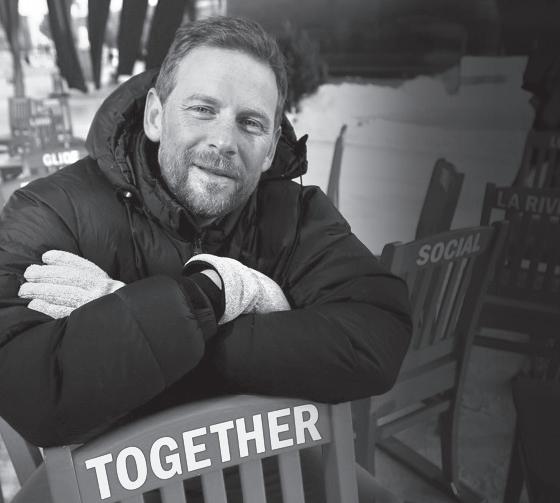
Montgomery creates experiments that challenge us to see our cities – and ourselves – in entirely new ways. His Home for the Games initiative led hundreds of people to follow his example and open their homes to strangers during the Vancouver 2010 Olympics. Working with the BMW Guggenheim Lab and the citizens of New York City, he transformed an empty lot into a machine to maximize feelings of altruism. Whether it is empowering people to reimagine a city street using hundreds of huge building blocks, or challenging them to hug total strangers, each experiment is driven by insights in the science of human well-being. Montgomery’s work nudges us out of our comfort zone to find a hopeful new vision for cities of joy.
Montgomery and his team have turned the lessons from Happy City into a tool for helping people bring more happiness into their cities. They are using it to transform places and people’s lives in Mexico City, Auckland, London and elsewhere. Montgomery launched the world’s first Happy Neighborhood Audit in Mexico City, and his team also began work with the World Health Organization’s Europe Healthy Cities Unit. Montgomery has also been working with Time magazine on an interactive survey exploring happiness in American cities. The Canadian Institute of Planners recently awarded Happy City with the 2020 Healthy Communities
Wed, May 10 / 7:30 PM / Campbell Hall

Co-presented with UCSB Library as part of UCSB Reads 2023, with support from the Office of the Executive Vice Chancellor

Planning Award for Planning Excellence. This award recognizes the firm’s Pavement-to-Plaza Well-being Assessment, a public study designed in partnership with the City of Vancouver.
Montgomery’s writings on urban planning, psychology, culture and history have appeared in magazines and journals on three continents. Among his awards is a Citation of Merit from the Canadian Meteorological and Oceanographic Society for outstanding contribution towards public understanding of climate change science. His first book, The Last Heathen, won the 2005 Charles Taylor Prize for literary nonfiction and vigorous praise from reviewers in The New York Times, The Guardian and elsewhere.
An award-winning program of the UCSB Library, UCSB Reads brings the UCSB and Santa Barbara communities together each year by reading a common book that explores compelling issues of our time.
Books are available for purchase in the lobby and a signing follows the event
Thu, May 11 / 7 PM (note special time) / Hahn Hall
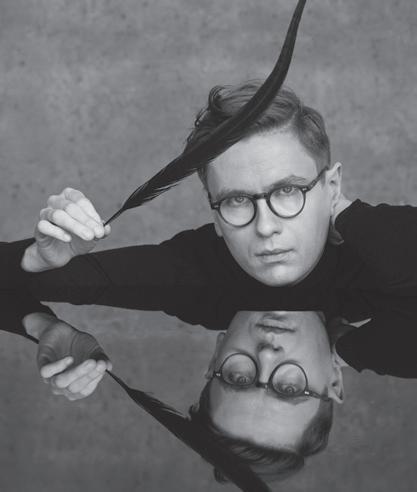
Running time: approx. 95 minutes, including intermission
Baldassare Galuppi: Piano Sonata No. 9 in F minor
I. Andante spiritoso
Wolfgang Amadeus Mozart: Rondo in F Major, K. 494
Carl Philipp Emanuel Bach: Rondo in D minor, H. 290
Domenico Cimarosa (arr. Víkingur Ólafsson): Sonata No. 42 in D minor
Wolfgang Amadeus Mozart: Fantasia in D minor, K. 397
Wolfgang Amadeus Mozart: Rondo in D Major
Domenico Cimarosa (arr. Víkingur Ólafsson): Sonata No. 55 in A minor
Joseph Haydn: Sonata in B minor, No. 47, Hob. XVI:32
I. Allegro moderato
II. Menuetto – Trio (Minore)
III. Finale. Presto
Wolfgang Amadeus Mozart: Kleine Gigue in G Major, K. 574
Wolfgang Amadeus Mozart: Piano Sonata No. 16 in C Major, K. 545
I. Allegro
II. Andante
III. Rondo. Allegretto
- Intermission -
Wolfgang Amadeus Mozart: String Quintet No. 4 in G minor, K. 516
III. Adagio in E flat major
Baldassare Galuppi: Piano Sonata No. 34 in C minor
I. Larghetto
Wolfgang Amadeus Mozart: Piano Sonata No. 14 in C minor, K. 457
I. Molto allegro
II. Adagio
III. Allegro assai
Wolfgang Amadeus Mozart: Adagio in B minor, K. 540
Wolfgang Amadeus Mozart: Ave verum corpus, K. 618
(Transcribed by Franz Liszt)
Artur Schnabel famously said of Mozart’s keyboard sonatas that they were “too easy for children and too difficult for artists.” It probably reflects rather poorly on me as an artist that even as a child I found Mozart’s piano music very difficult. In fact, being assigned the C major Sonata misleadingly called the “Sonata facile” (easy sonata) as an eight-year-old piano student led to my first ever encounter with real struggle in music. As early as the fifth measure there were runs of notes I agonized over; runs which, like so much of Mozart, look deceptively innocent on the page but are strangely difficult in practice. The more I practiced, the worse they sounded. My inner turbulence escalated over a few days and reached a boiling point one afternoon when, in an outburst of anger, I grabbed a pencil and scrawled over the whole score. My relief was shortlived, however, as my mother soon discovered the sacrilege which had taken place in our living room. I was duly made to erase all of it, every little scratch. I still have the score, and the scars are still visible on the old pages today, but my relationship with the music is much improved. I have often since wondered: Was it really the scales? Or was I, even at this early age, weighed down by the excess baggage that the idea of Mozart brings with it? Did the inescapably unfavorable comparison I childishly made between my ordinary self and the genius of the “eternal child” Mozart come in between me and the music?
Far from the glowing image of the angelic prodigy, the music on this program is mostly by the Mozart of the 1780s, a grown man and a mature composer who in the preceding years had come to know adversity: painful disappointment and humiliation as his attempts at gaining suitable employment came to nothing; loss and grief as his mother passed away during his fruitless and frustrating Paris sojourn and finally exile and a disinheritance of sorts from not only his home town of Salzburg but from the patriarchal family unit. At the same time, he had spread his wings and set out for freedom as he moved to Vienna and married Constanze Weber, much to the dismay of his father. This is the Mozart who was eager to escape the long shadow of his small former self and prove himself a serious musical force worthy of attention. And this is
the Mozart that, at least for a few years, was able to sustain himself as an independent musician in a very contemporary sense, organizing his own concert series at repurposed, off-beat venues, securing the necessary number of subscription holders, writing the music, practicing the piano parts, rehearsing the orchestra –even printing the admission tickets. I find this period of Mozart’s life and art endlessly fascinating – in part because his resourcefulness and hard work could not be further from the old “idiot savant” view of Mozart as a helpless, passive vessel of divine genius. Primarily, though, I love this Mozart because of the music itself. During this decade, Mozart was not just a composer but a virtuoso pianist; and, writing for himself in this role, I feel he indulged more than ever in the sublime playfulness that lay at the core of his originality and inventiveness. This is the period when Mozart was not just perfecting the Classical tradition but subtly subverting it, his graceful touch as featherlight as always but the shadows darker, the nuances and ambiguities more profound. And, while he was reaching into the realm of the Romantic future that lay ahead, he enthusiastically engaged with the past, embracing the baroque elements that deeply enriched his music’s scope and impact.
I have chosen to present some of my favorite keyboard works of Mozart in the company of works by a small selection of leading contemporaries. Two of these, Carl Philipp Emanuel Bach (1714-1788) and Joseph Haydn (1732-1809), were closely connected with Mozart in both music and spirit. The other two, Baldassare Galuppi (1706-1785) and Domenico Cimarosa (17491801), were more distant, without significant direct links to Mozart, but belonged to the same ecosystem of 18th-century music. As the center of musical life in Europe arguably shifted north during the maturation of the Classical style that took place during Mozart’s lifetime, the two Italian composers and the two Austro-Germanic ones represent not only different geographies, but the different aesthetic values that coexisted. Perhaps all four provide a chance to calibrate the contemporary ear towards the prevailing ideas, styles and tastes of the times. To me, they offer a kind of echo of the age. It is my hope that this particular context, a mix of the celebrated and the obscure, can slightly alter our psychological attunement, removing some of the baggage we all bring with us as we come to Mozart’s music. This is in any case what I set out to do for myself: to approach even the best-known works
of Mozart with the same freedom, childlike enthusiasm and spirit of discovery that come with trawling through the almost-never-recorded works of the likes of Galuppi and Cimarosa in search of unknown gems.
The program opens with a movement by the Venetian Galuppi, an influential champion of the galant style and prolific composer of comic operas, widely celebrated in his day but largely forgotten outside Italy by the end of the 18th century. The motivation behind reading through his available keyboard music (most of which is undated) came from encountering, many years back, Arturo Benedetti Michelangeli’s impeccably stylish 1962 video recording of the sunny C major Sonata No. 5. In the Andante spiritoso, the opening movement of the composer’s F minor Sonata No. 9, an entirely different atmosphere reigns. I found in it a similar elusive combination of darkly-polished elegance and apprehensive energy as in the opening measures of Mozart’s late G minor Symphony. With its dusky hues, the movement serves as a prelude to the bright F major of the Mozart Rondo K. 494 that follows. Similarly, I have positioned another sonata movement of Galuppi’s, the Larghetto in C minor, to set the scene with its hypnotic arpeggios before Mozart’s C minor Sonata. Although he was born 43 years later, the musical career of the Neapolitan Cimarosa bore many similarities with that of Galuppi. Like Galuppi, he enjoyed great international success with his comic operas (most notably his 1792 opera Il matrimonio segreto) and, like Galuppi, he joined a long succession of Italian composers to be engaged for a time at the court of Catherine the Great in St. Petersburg. Following a tip from a friend, I indulged in a similar treasure hunt in the selection of his available keyboard works, unearthing the two “sonatas” (presumably movements from larger works) on this album, the Sonata in D minor and the Sonata in A minor. Both have a lamenting, arioso quality and subtle evocations of Vivaldi in the background. The original scores are written in a rather sparse manner and I have taken the liberty of harmonizing them as I have arranged them for the modern piano.
Never shy to admit influence, Mozart had affectionate ways of acknowledging his gratitude to both Carl Philipp Emanuel Bach – of whom he famously said, “Bach is the father, we are the children” – and Joseph Haydn, whose friendship he cherished to the point of dedicating a set of six string quartets to him. C.P.E.
Bach’s Rondo in D minor stems from his collection of six Clavier-Sonaten für Kenner und Liebhaber (Keyboard Sonatas for Connoisseurs and Amateurs), written in his late years, 1779-1787, within roughly the same time frame as the Mozart works on this program. I found it an irresistible choice next to Mozart’s work in the same form, as the two approaches are so different – yet imbued with a similarly alluring sense of surprise, virtuosity and quick-wittedness. Bach’s refreshingly original Rondo possesses the hallmarks of the empfindsamer Stil (sensitive style) – unexpected diversions, countless twists and turns and articulate changes in temperament. Joseph Haydn was himself no stranger to musical surprise and these same elements are at play in his Sonata in B minor, a riveting work which seems to carry within itself the seeds of Romanticism and at the same time retain a sense of Baroque majesty.
Mozart’s variety of surprise is somehow different from anyone else’s. Musical expectations are often both met and challenged at the same time with an unanticipated twist; every familiar trope of the Classical style made fresh by some ingenious, subtle invention. That is how I feel when I play the F major Rondo K. 494 of 1786. Even the staple Alberti bass underneath is inverted, starting the whole work off on a light, nimble footing, and what may seem simple at first glance proves upon further exploration to be magnificently complex in detail. The amiable main theme is never heard twice in the same way on each of its four outings – not even close. The imagination of the Classical era’s most gifted improviser was simply too vivid to allow for mindless repetition. The twists and turns of these twelve measures are too many to list, undeniably minute yet gloriously indispensable.
Mozart’s Fantasia in D minor K. 397 is another work where his improvisatory brilliance is on full display, its darkly mysterious atmosphere almost like stepping into a state of altered consciousness. The performer has to retain a sense of uncertainty, of traversing into the mist without knowing what comes next, no matter how often the work has been rehearsed or performed. The date of the work has been subject to debate, but is often put at 1782, a year after Mozart’s first encounter with the works of Johann Sebastian Bach. It has been suggested that he intended this work as a prelude to an accompanying piece – possibly a fugue. Not entirely convinced by the various ways in which the unfinished
D major section has been posthumously drawn to a close by other composers and performers, I decided to end the work where the D minor section finishes on a dominant chord and leads into an unrelated work: the quick-paced Rondo in D major K. 485. Mozart the keyboard virtuoso feels very present in this piece, its cheerful character in direct contrast with the preceding Fantasia. There is hardly a minor chord to be heard throughout (and then only in what seems like jest). Every possible side of the limited thematic material (there really is only one theme here) is illuminated at some point in this ever-modulating tour de force.
The Kleine Gigue K. 574 is a small miracle of ingenuity which seems to take the tragic opening subject of J.S. Bach’s last fugue from the first book of The WellTempered Clavier and twists it into a high-spirited and superbly-crafted one-and-a-half-minute tribute to the old master. It was written on 16 May 1789 in Leipzig (on Mozart’s second detour to the city on his long Berlin trip). To me, none of Mozart’s works on this album would have been conceivable without his engagement with Bach’s music, introduced to him by his friend and patron, the Dutch-born diplomat and librarian Gottfried van Swieten, early in his Vienna years. But in this small piece, after Mozart had had the chance to improvise on Bach’s themes at the grand organ of the St. Thomas Church and leaf through Bach’s autographs, their relationship feels personal and intimate.
The G minor String Quintet K. 516 from 1787 was written, along with its sister piece in C major, for the ensemble of two violins, two violas and cello. Mozart intended to publish the music himself, using a subscriber model as he did in his Vienna concert series. Failing to secure a sufficient number of buyers for the works, he was forced to abandon this plan and the works were in the end sold to a music publisher for a meager sum. Two years later, his concert series would meet the same fate, as only one patron was willing to subscribe – the aforementioned Gottfried van Swieten. The G minor Quintet’s tragic atmosphere has been linked by some to Mozart’s dwindling success in Vienna, increasing financial worries and his father’s illness and impending death. The Adagio movement in E flat major offers a moment of grace and consolation. According to one account (by Austrian composer Maximilian Stadler), Mozart performed the work himself at one point, playing one of the two violas in this quintet, with his friend Haydn playing the other. It is easy to imagine the warmth and kindred spirit of that ensemble. However, the sublime music also lends itself
wonderfully to a solo piano transcription, something that has tempted me for years.
Following my encounter with the “Sonata facile” K. 545 described above, it would be years before I realized that this sonata was not written by the child Mozart, as I had envisioned. And, far from circumstances of perfect musical happiness, this C major sonata was in fact written at a time, 1788, when Mozart’s fortunes had reversed, as Austria’s war with the Ottoman Empire had brought on an economic recession that rendered his concert activities unsustainable. As success in the opera world had yet to materialize, teaching provided a stable source of income for him. It is to this economic necessity that we owe so many of the solo keyboard pieces, including this perfectly distilled work, described by Mozart himself as “a little piano sonata for beginners,” which somehow seems to reflect back to Mozart’s own beginnings, almost as if recreating happier, simpler times.
If there is a hint of nostalgia in the C major Sonata, the grand, theatrical tragedy of the C minor Sonata K. 457, however, foreshadows the turbulent Romantic era that lay ahead. It is all but impossible to imagine Beethoven writing his “Pathétique” Sonata without Mozart’s C minor Sonata paving the way. There are striking similarities in numerous passages in the opening movement. In the second movement Mozart’s third theme, in A flat, seems to be the model on which Beethoven based his famous second movement melody, also in A flat. Overall, the work feels strikingly bold in conception, its dynamic contrasts pushing the boundaries of what was yet possible on the ever-evolving keyboard instruments of the day.
The two mediums of string ensemble and solo keyboard were not far apart in Mozart’s mind, as evident in his transcriptions of J.S. Bach’s keyboard fugues for string quartet, dating back to his discovery of Bach’s music. Having allowed myself to transcribe the Adagio from the G minor String Quintet for solo piano, I must now conversely admit that the beautifully organized four-part writing of the late B minor Adagio K. 540 has often made me feel as if I were playing a piece for string quartet. Written in March 1788, the Adagio balances dark, introspective tension with tender meditation throughout – and the way it resolves into B major at the end feels like forgiveness itself.
In his piano transcription of Mozart’s Ave verum corpus K. 618 (1791), Franz Liszt allows himself to marvel at Mozart’s genius in his 19th-century way. There is a sense of death and transfiguration as the music moves up into the starry firmament of the piano’s upper register – Mozart has become an angel of sorts. In one
of his incomprehensible compositional feats, Mozart’s original choral motet was created in what appears to have been the spur of the moment during his visit to the spa town of Baden bei Wien, where Constanze was staying, pregnant with their sixth child. Mozart had six months to live. He wrote the motet as a present for his friend, the parish cantor, to be performed a few days later at the Mass of Corpus Christi. Intended for a provincial choir and not overly ornate, there is a lucid clarity about its expressive beauty and, despite the swiftness of its creation, every detail seems perfectly thought through. Two hundred and thirty years on, this music disarms us in a way words can hardly express.
Icelandic pianist Víkingur Ólafsson has made a profound impact with his remarkable combination of highest level musicianship and visionary programs. His recordings for Deutsche Grammophon – Philip Glass Piano Works (2017), Johann Sebastian Bach (2018), Debussy Rameau (2020) and Mozart & Contemporaries (2021) – captured the public and critical imagination and have led to career streams of over 400 million. His latest album, From Afar, was released in October 2022.
One of today’s most sought-after artists, Ólafsson has garnered multiple awards including the Rolf Schock Prize for music (2022), Gramophone magazine Artist of the Year, Opus Klassik Solo Recording Instrumental (twice) and Album of the Year at the BBC Music Magazine Awards.
Ólafsson continues to perform as artist in residence at the world’s top orchestras, concert halls and festivals and works with today’s greatest composers. In the 2022-2023 season he performed with orchestras including Philharmonia Orchestra, Concertgebouworkest, Czech Philharmonic Orchestra, New York Philharmonic, Berliner Philharmoniker, The Cleveland Orchestra, the London and Bergen philharmonic orchestras, Toronto and Orchestre symphonique de Montréal.
A captivating communicator both on and off stage, Ólafsson’s significant talent extends to broadcast, having presented several of his own series for television and radio. He was artist in residence for three months on BBC Radio 4’s flagship arts program, Front Row. Broadcasting live during lockdown from an empty Harpa concert hall in Reykjavík, he reached millions of listeners around the world.
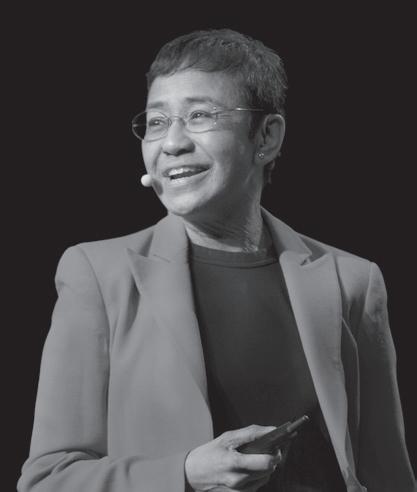
Thu, May 18 / 7:30 PM / Campbell Hall
Major Sponsor: Dorothy Largay & Wayne Rosing
Justice for All Lead Sponsors: Marcy Carsey, Connie Frank & Evan Thompson, Eva & Yoel Haller, and Zegar Family Foundation
Additional support provided by the Beth Chamberlin Endowment for Cultural Understanding
Presented in association with UCSB Carsey-Wolf Center
Maria Ressa is the co-founder, chief executive officer and executive editor of Rappler.com, an online news organization in the Philippines. Ressa’s courage and work on disinformation and what is commonly referred to as “fake news” culminated in her being awarded the 2021 Nobel Peace Prize, recognizing her “efforts to safeguard freedom of expression, which is a precondition for democracy and lasting peace.” Her numerous awards include being named Time magazine’s 2018 Person of the Year and listed among its 100 Most Influential People of 2019 and its most influential women of the century. She was also among BBC’s 100 Women 2019 and Prospect Magazine’s World’s Top 50 Thinkers 2019.
A journalist for more than 36 years, Ressa was CNN’s bureau chief in Manila before working as CNN’s lead investigative reporter focusing on terrorism in Jakarta. In 2012, she co-founded Rappler, an online news platform with the ethos of a small tech start-up, starting with a team of 12 young reporters and developers. Harnessing the emerging power of social media, Rappler crowdsourced breaking news, found pivotal sources and tips, harnessed collective action for climate change and helped increase voter knowledge and participation in elections. Through the power of social media, Rappler has grown into the fourth-largest news website in the Philippines, with over 100 journalists. Ressa has been arrested on 10 charges related to exposing the Duterte government’s corrupt practices and was convicted of cyber-libel in 2020. While she faces years in prison and thousands in fines, she is out on bail pending her appeal,
but true to form, Ressa vows to keep fighting.
She is part of the founding group of The Real Facebook Oversight Board – composed of 25 academics, journalists and activists demanding reforms to protect the public sphere. She is one of 10 experts named by United Nations Secretary General António Guterres to his inaugural Internet Governance Forum Leadership Panel. She also advises organizations on corporate governance, values and strategy.
Ressa authored Seeds of Terror: An Eyewitness Account of Al-Qaeda’s Newest Center of Operations in Southeast Asia and From Bin Laden to Facebook. Her most recent book How to Stand Up to a Dictator tells the story of how democracy is vulnerable and social media is killing our freedoms.
She was featured in the 2020 documentary A Thousand Cuts, which profiles her fearless reporting on the abuses of Duterte’s presidency while also illustrating social media’s capacity to deceive and entrench political power.
Ressa has vowed to keep fighting and to continue Rappler’s journalism.
Books are available for purchase in the lobby and a signing follows the event
Mon, May 22 / 7:30 PM / Campbell Hall
Justice for All Lead Sponsors: Marcy Carsey, Connie Frank & Evan Thompson, Eva & Yoel Haller, and Zegar Family Foundation Presented in association with the UCSB Office of Diversity, Equity, and Inclusion, Congregation B’nai B’rith, Jewish Federation of Greater Santa Barbara, and Santa Barbara Hillel
Jonathan A. Greenblatt is the chief executive officer of ADL (Anti-Defamation League) and its sixth national director. As chief executive of ADL, Greenblatt leads all aspects of the world’s leading anti-hate organization. He is an accomplished entrepreneur and innovative leader with deep experience in the private, public and nonprofit sectors.
Since becoming CEO in July 2015, Greenblatt has modernized ADL while refocusing it on the mission it has had since its founding in 1913: to fight the defamation of the Jewish people, and to secure justice and fair treatment for all.
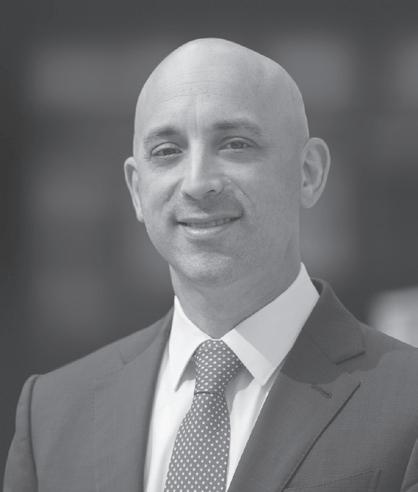
Under Greenblatt, ADL has modernized its operations, innovated its approaches to counter antisemitism from all sides and enhanced its efforts to combat extremism in all forms. During his tenure ADL rebooted its Center on Extremism that analyzes and monitors extremists and hate groups; launched Never Is Now, the largest annual convening in the world focused on antisemitism and hate; created the Center for Technology and Society in Silicon Valley to fight the rising tide of online hate and harassment; partnered with the Aspen Institute to launch the Civil Society Fellowship, an innovative program that builds cohorts of emerging leaders across a continuum of ideology and identity; developed the Sports Leadership Council to engage athletes, teams and leagues to confront bigotry and discrimination more effectively; and executed Stop Hate for Profit, the successful campaign that organized businesses, celebrities, nonprofits and policy makers to fight the rampant racism, antisemitism and extremism on Facebook.
In 2022, Greenblatt released It Could Happen Here, a book that sounds an alarm, warning that hate and systemic violence is gathering momentum in the United States –and that violence on a more catastrophic scale could be just around the corner.
Greenblatt serves on numerous corporate and non-profit boards and has been recognized on multiple occasions for his leadership at ADL. He has been named by The NonProfit Times to its list of Top 50 Nonprofit Leaders from 2016-2020. Recode named Greenblatt to its inaugural Recode 100, a list of the top 100 people in business and technology. He has been named among the Top 50 Most Influential Leaders in the global Jewish community by The Jerusalem Post and as one of the Top 50 Jews to follow on Twitter by the Jewish Telegraphic Agency.
Before ADL, Greenblatt served in the White House as special assistant to President Obama and director of the Office of Social Innovation. He came to that role after a long career in business. In 2002, he co-founded Ethos Brands, the business that launched Ethos Water, a premium bottled water that helps children around the world access clean water. Ethos was acquired by Starbucks Coffee Company in 2005. Following the acquisition, Greenblatt was named vice president of Global Consumer Products at Starbucks and joined the board of the Starbucks Foundation.
In 2009, Greenblatt founded All for Good (AFG), the largest database of volunteer opportunities on the Internet. Incubated at Google, AFG developed
an innovative strategy to organize the world’s volunteer listings. AFG was acquired by Points of Light in 2011. Greenblatt also served as CEO of GOOD Worldwide, a diversified media company, and as an executive at Realtor.com, joining the company as a product manager and eventually heading up its consumer products division. Realtor went public in 1999 (HOMS) and was acquired by News Corp in 2014.
Greenblatt has served as an adjunct faculty member at the Anderson School of Management at UCLA and as a senior fellow at The Wharton School of the University of Pennsylvania. He is a Henry Crown Fellow of the Aspen Institute and a member of the Council on Foreign Relations.
Greenblatt graduated cum laude with a BA from Tufts University and earned his MBA from the Kellogg School of Management at Northwestern University.
Books are available for purchase in the lobby and a signing follows the event
Special Thanks:
Tue, May 9 / 8-11 PM / FREE




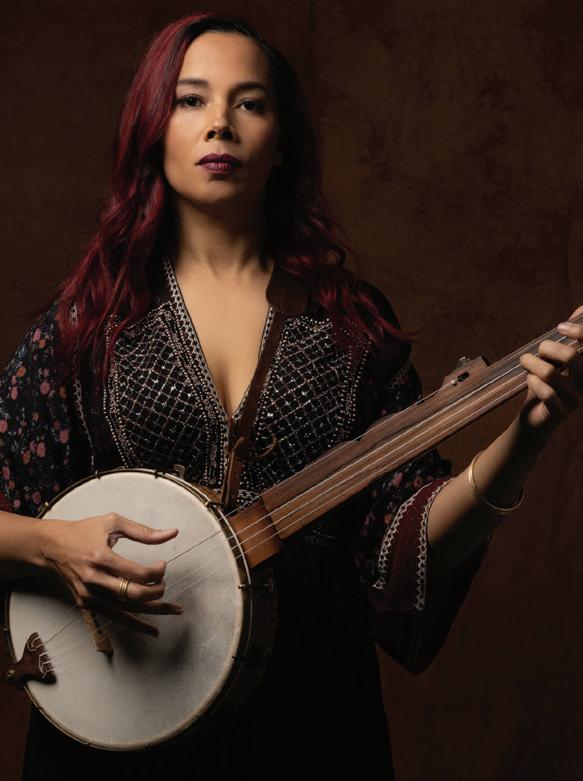
UCSB Art, Design & Architecture Museum

“The solace, the strength, and the sense of solidarity we all need right now.”
– Jay Xu, Asian Art Museum Director, San Francisco

Featuring 30 artworks by anonymous international artists, this large-scale public art projection responds to systemic gender inequity and discrimination in Iran.
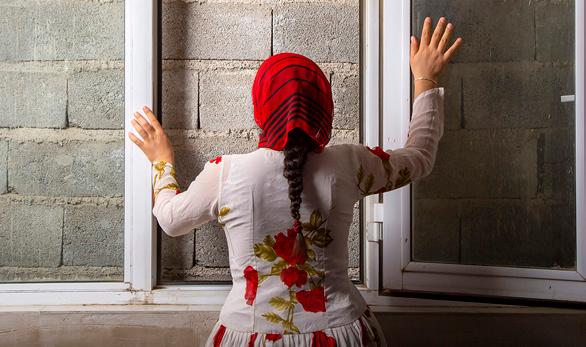
The Leta Santa Barbara Goleta, Tapestry Collection by Hilton is the heart of the good life, home to several innovative companies.
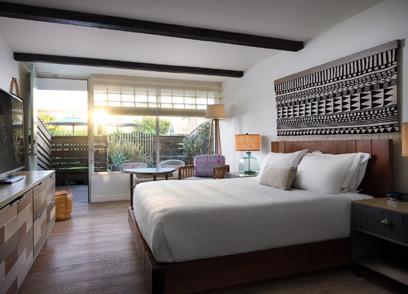
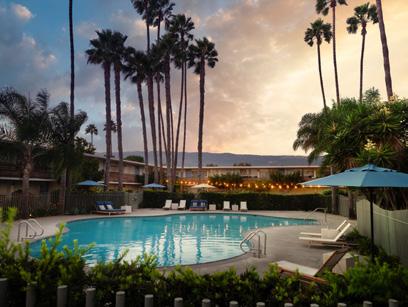
CAYA Restaurant and Bar, "Come As You Are" and experience a modern culinary adventure.

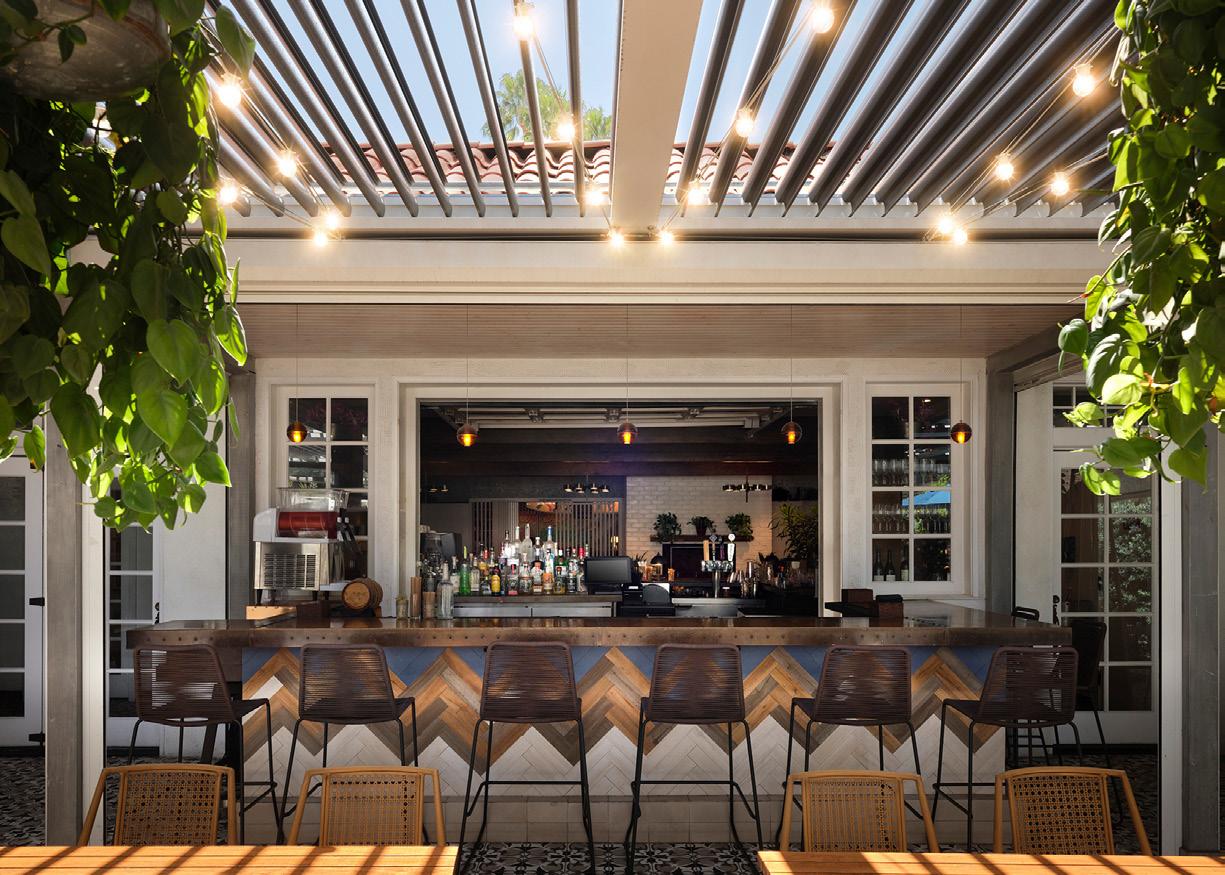
Minutes from Santa Barbara Airport; Goleta Amtrak Station and the University of California, Santa Barbara.
THELETA.COM @THELETAHOTEL
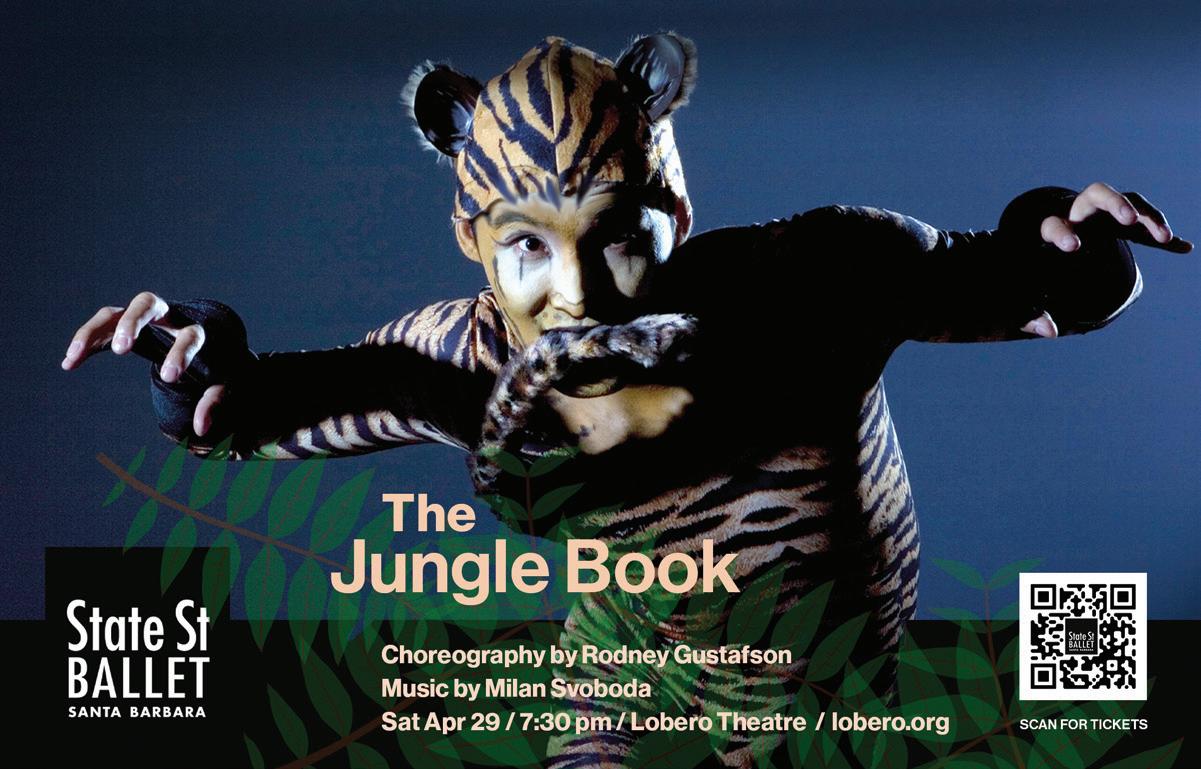
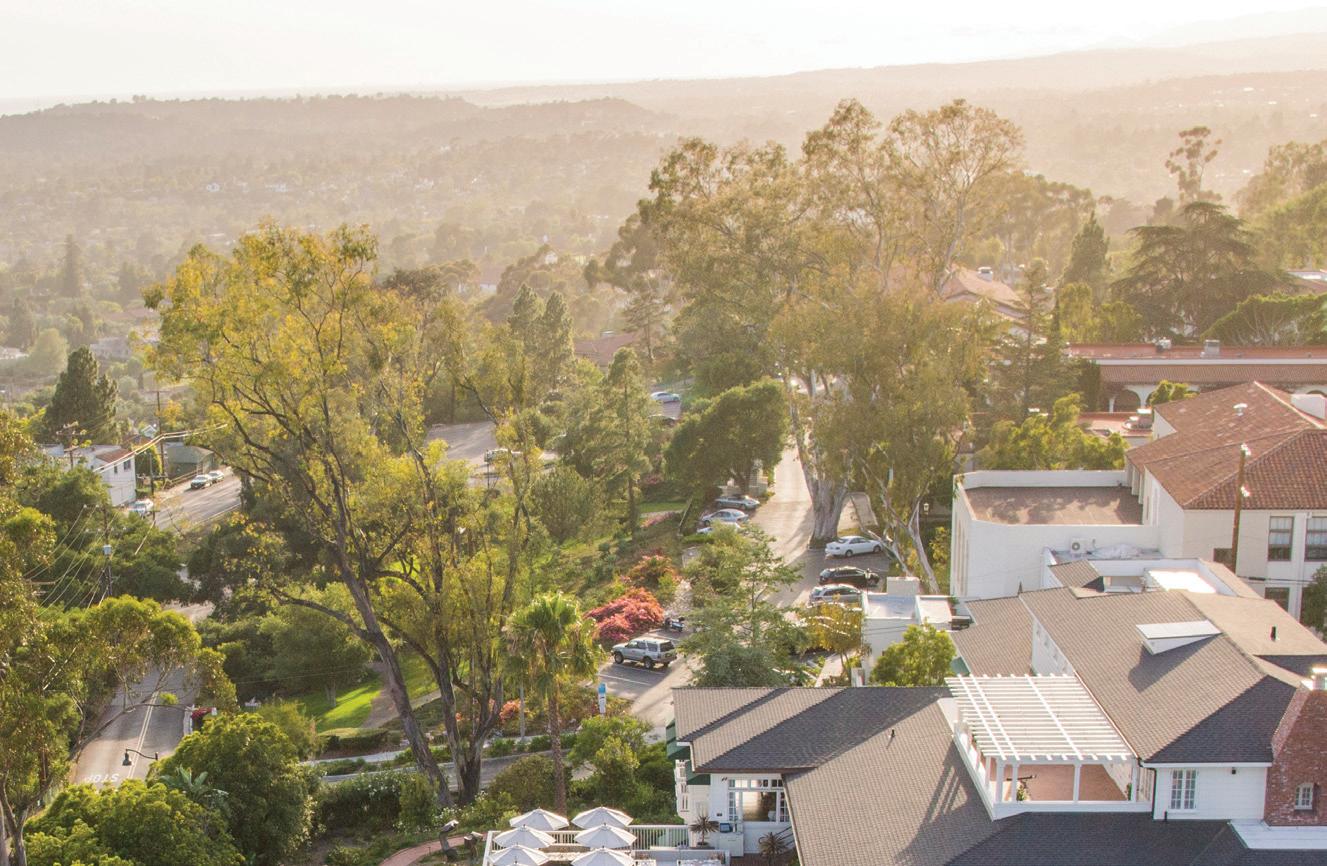


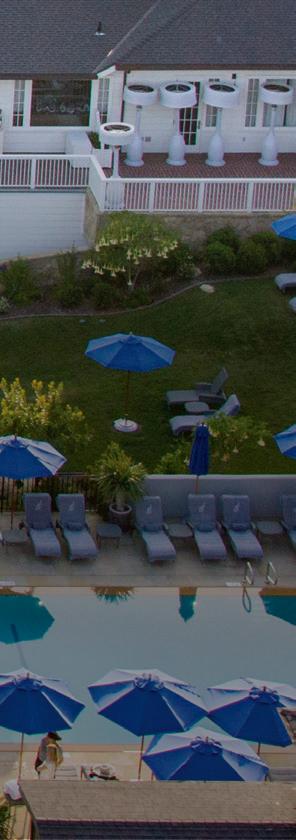


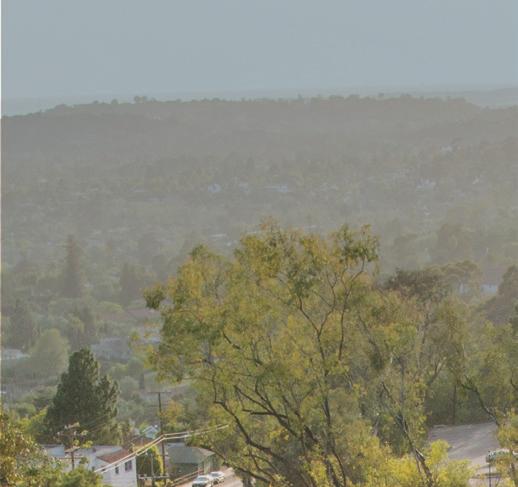
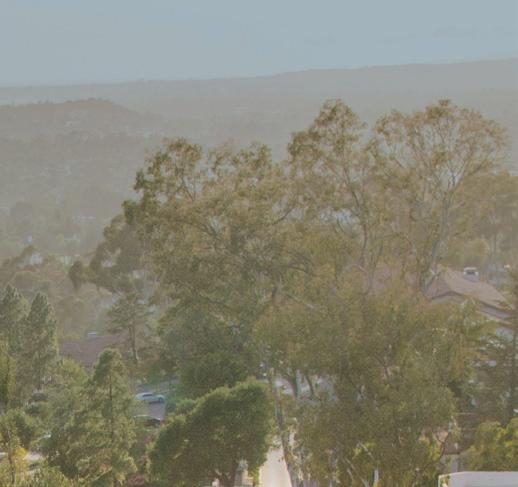
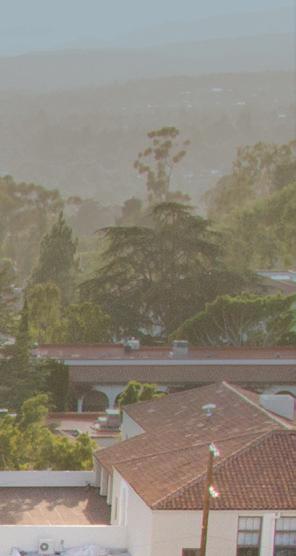


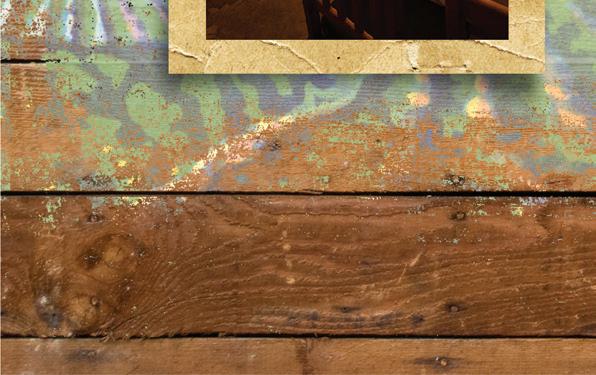
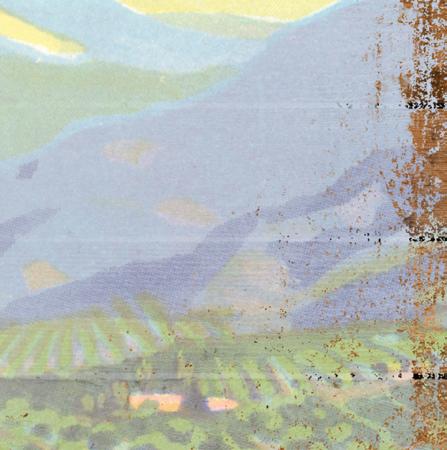
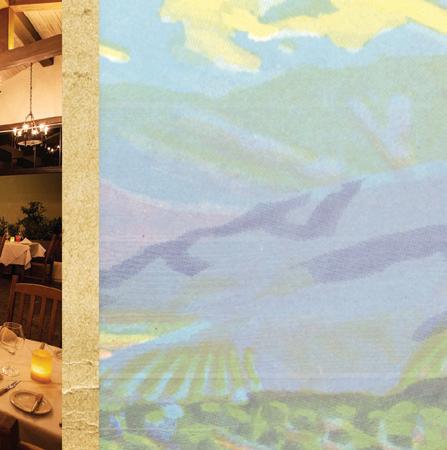

Fresh, local ingredients, prepared with care. Excellent wines that reflect the quality and character of our region and work in concert with the cuisine. Warm, inviting ambience with engaging service at a relaxed, leisurely pace. is is bouchon.
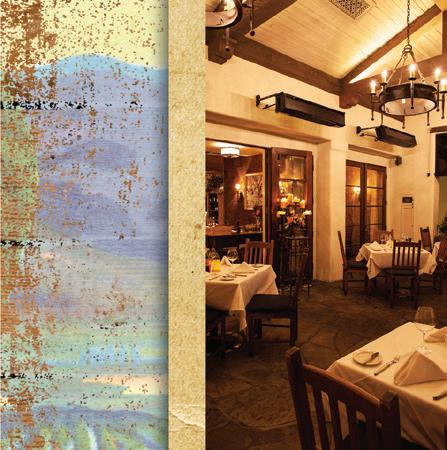


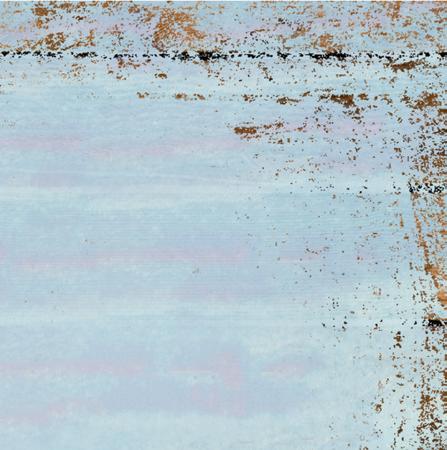

dinner nightly Sunday- ursday 5-9pm | Friday-Saturday 5-10pm
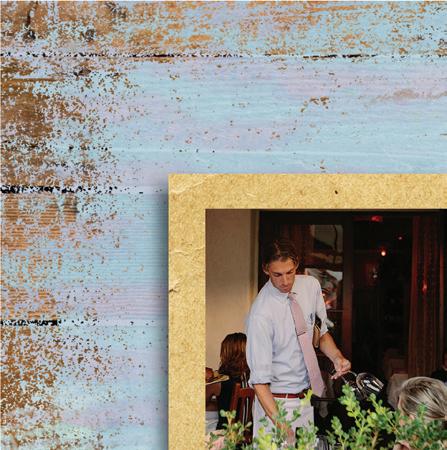





The SBCC Promise provides all recent, local high school graduates with the opportunity to pursue their dreams at Santa Barbara City College, covering all fees, books, and supplies for two years.
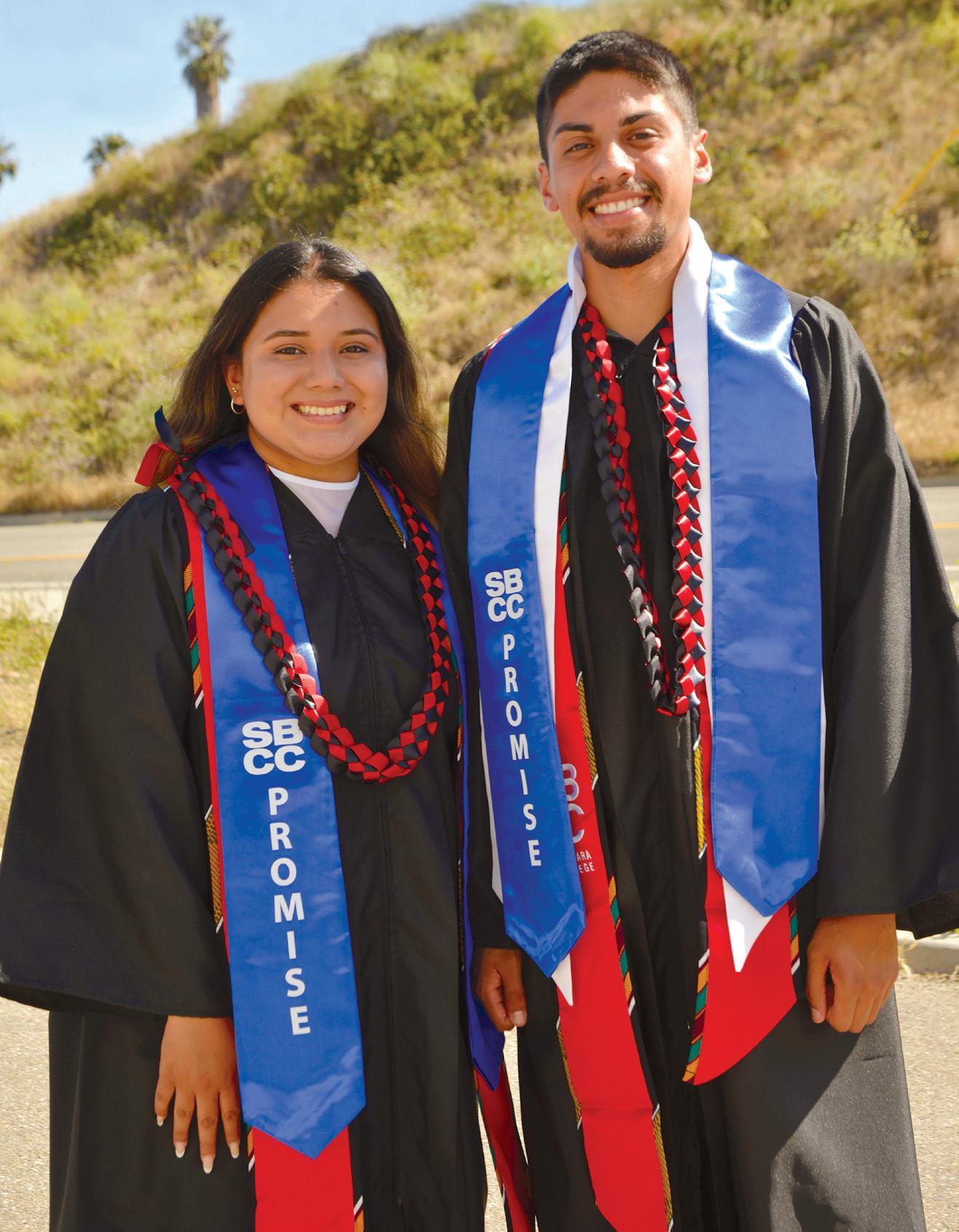
The SBCC Foundation partners with generous businesses, individuals, and organizations to invest in our community’s college, supporting the SBCC Promise, student success programs, scholarships, emergency grants, and more.
Your gift makes it possible.
sbccfoundation.org
Photo: Nell Campbell